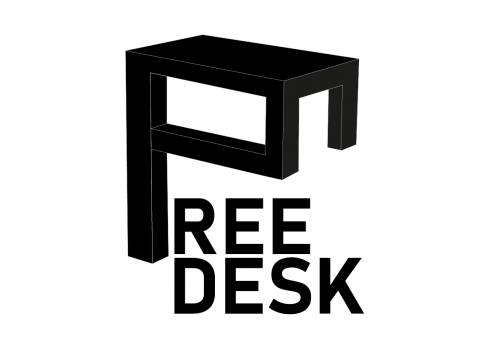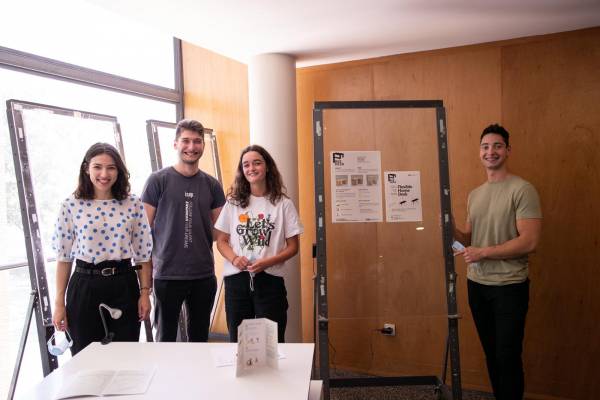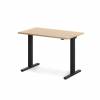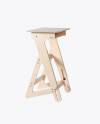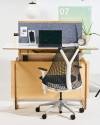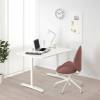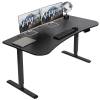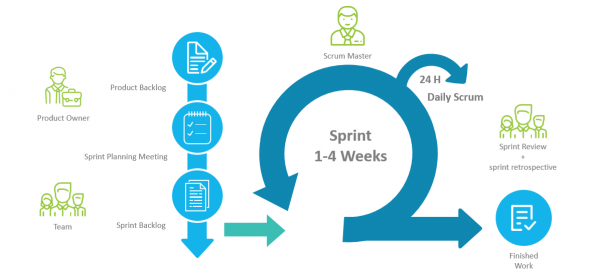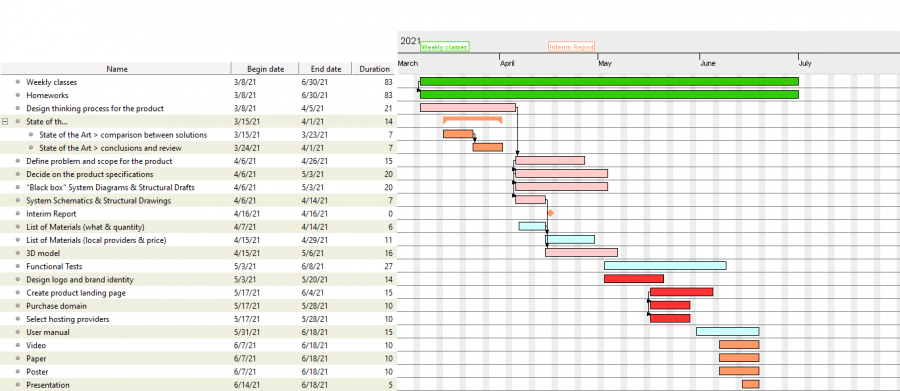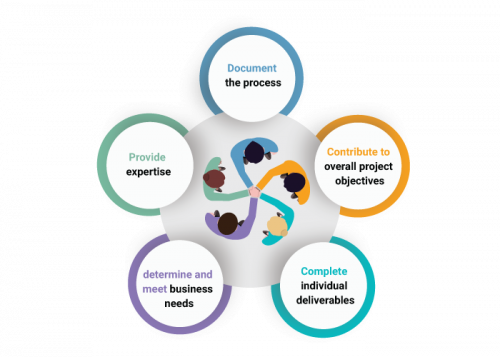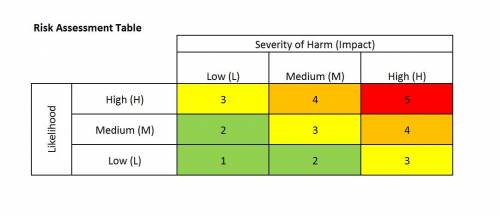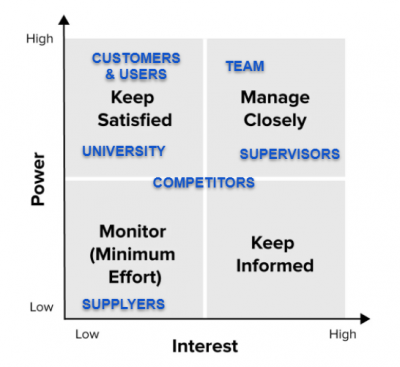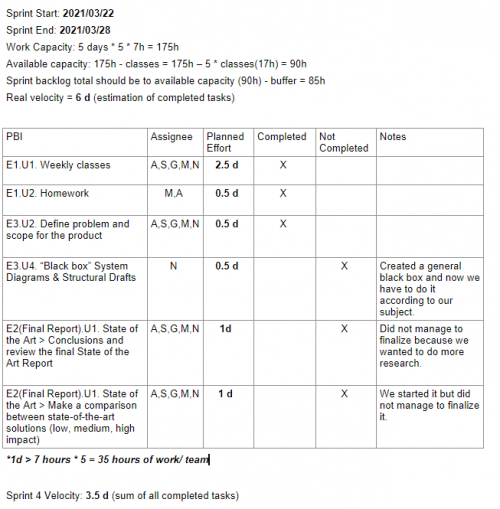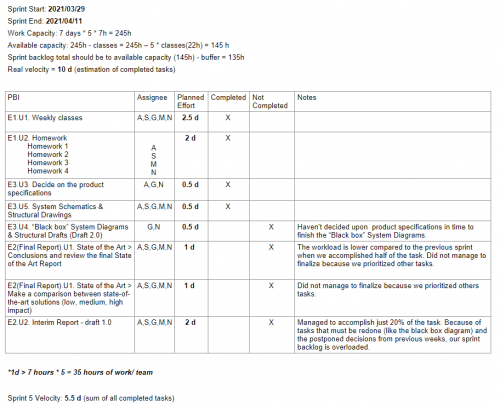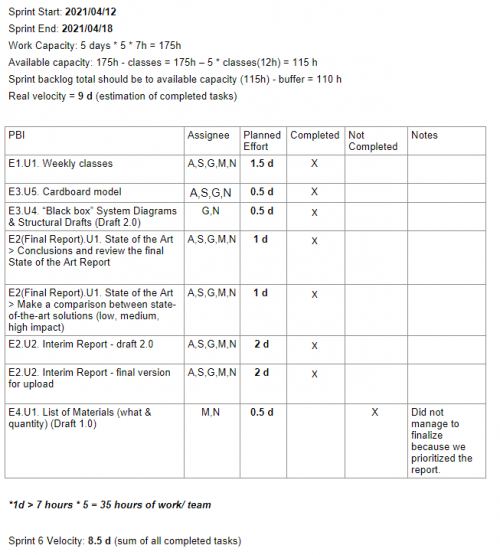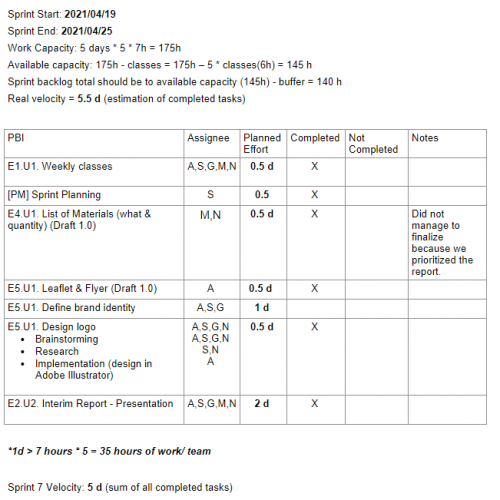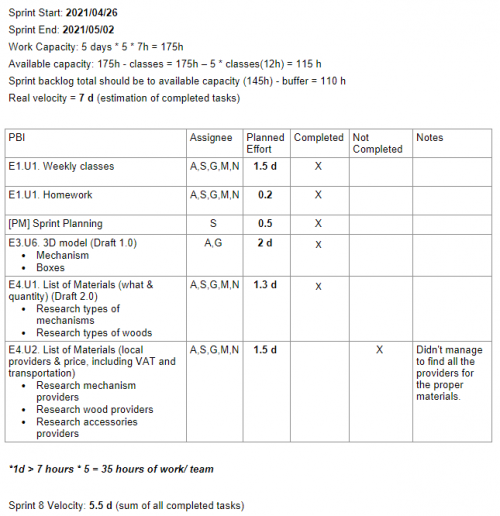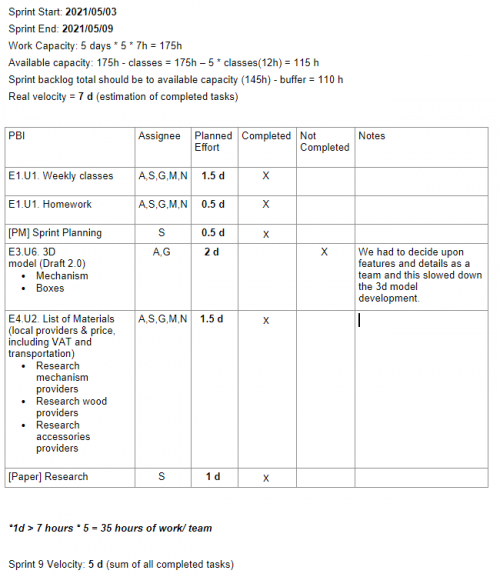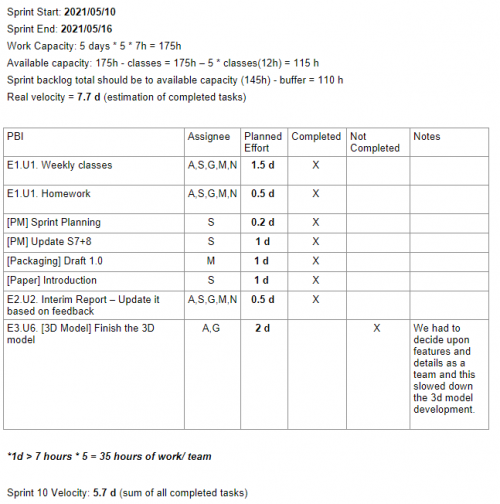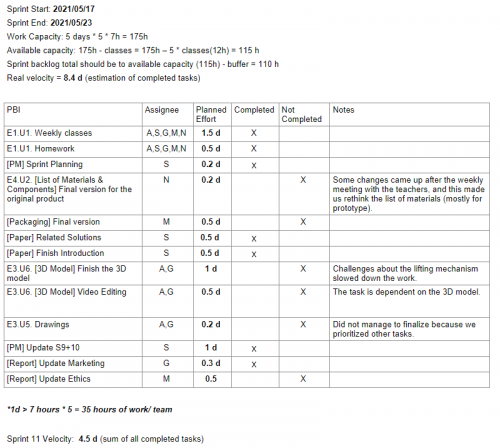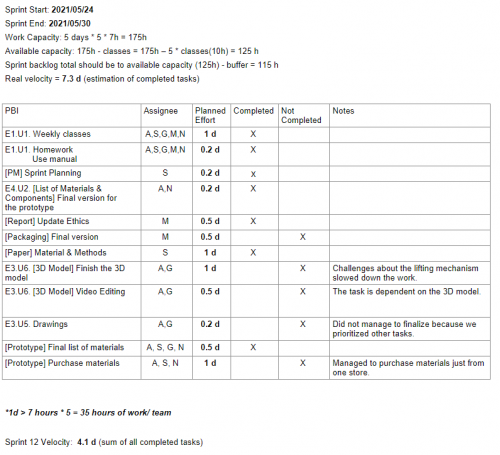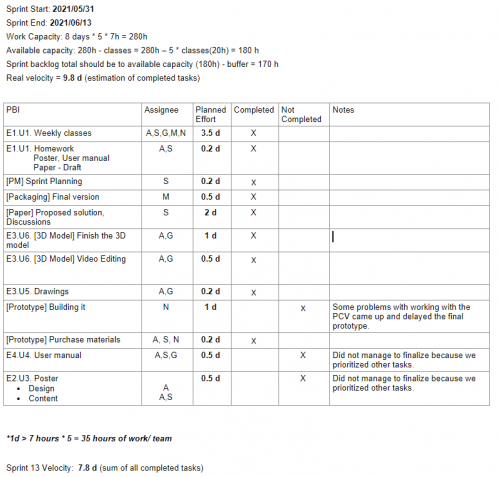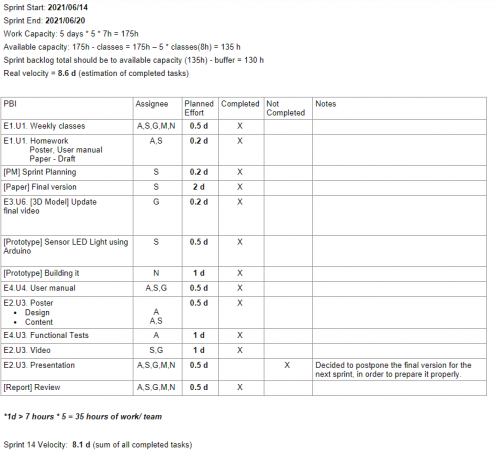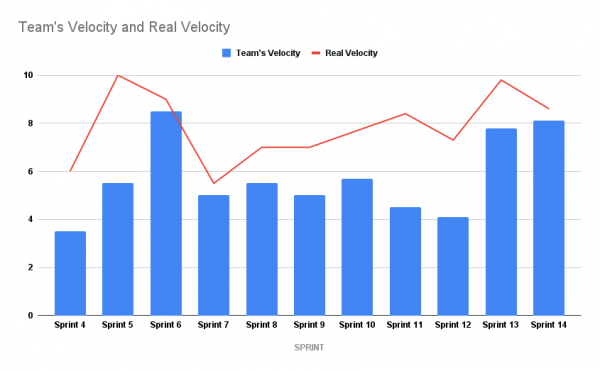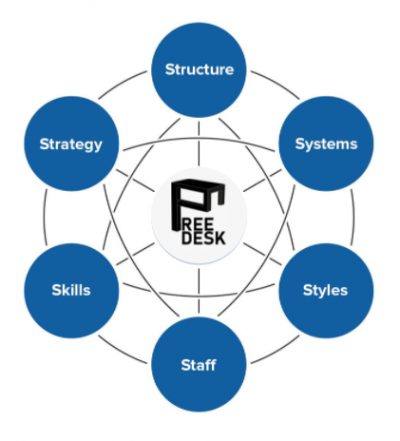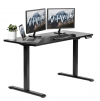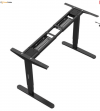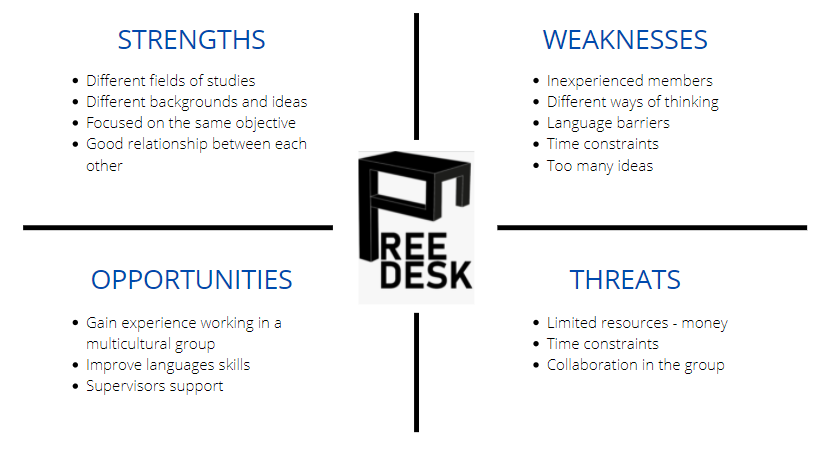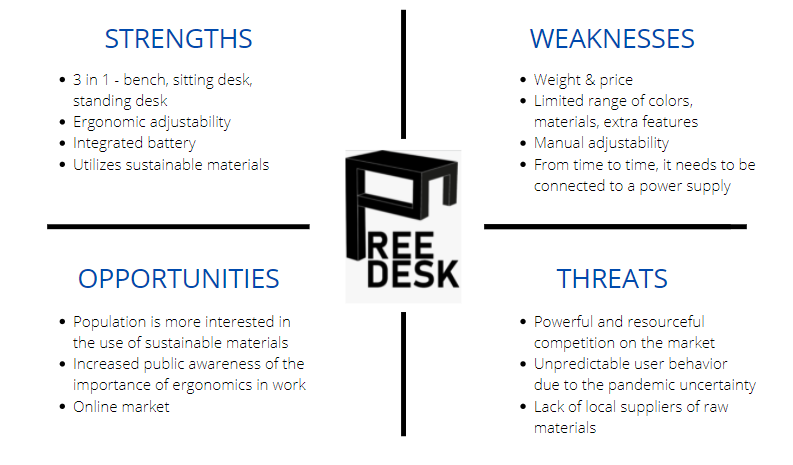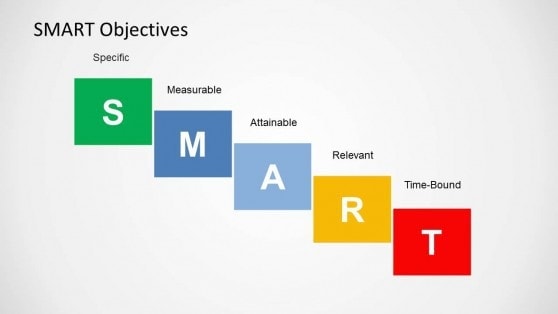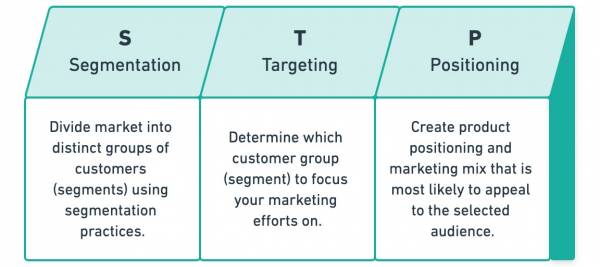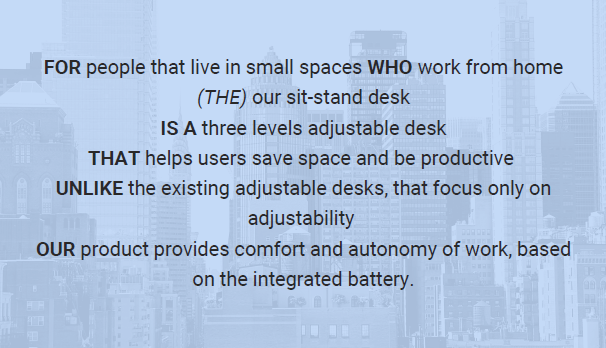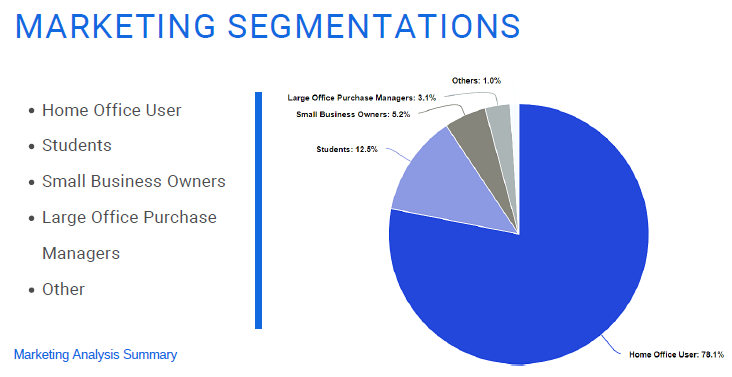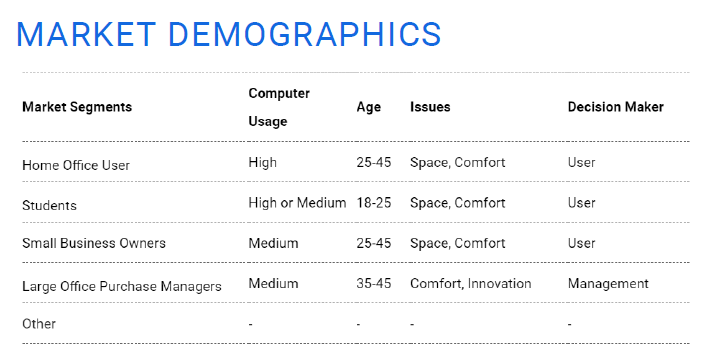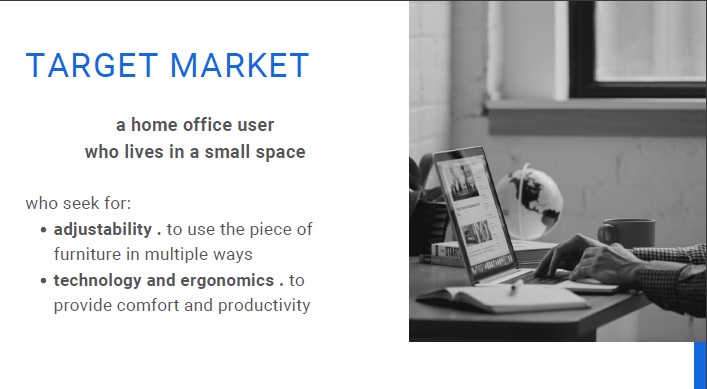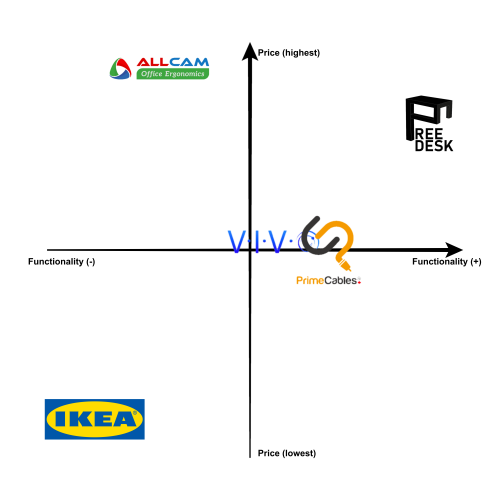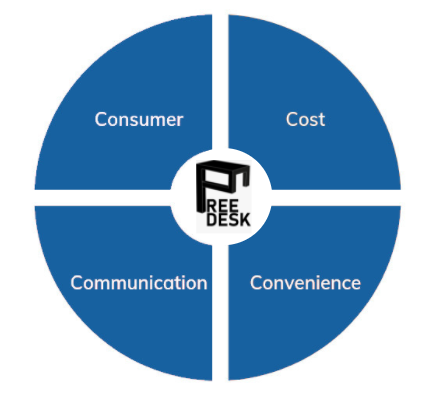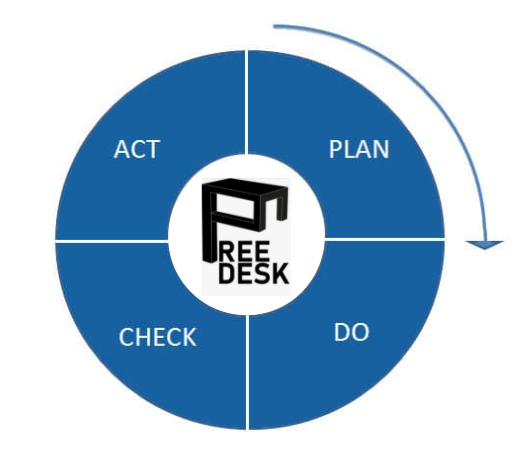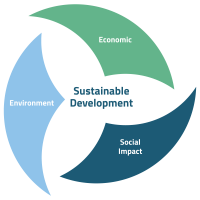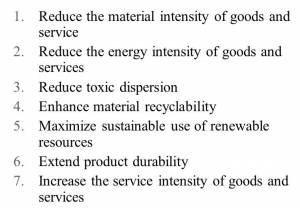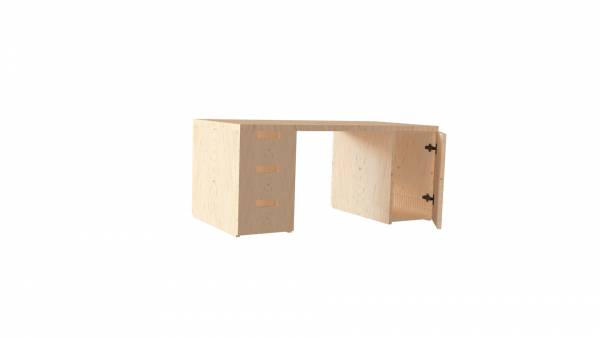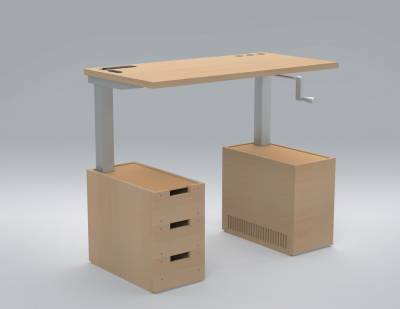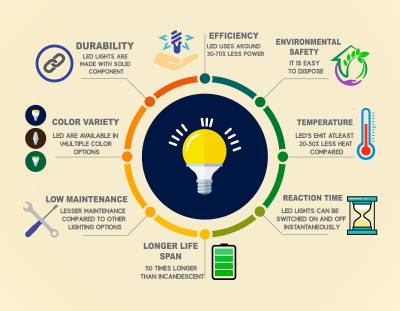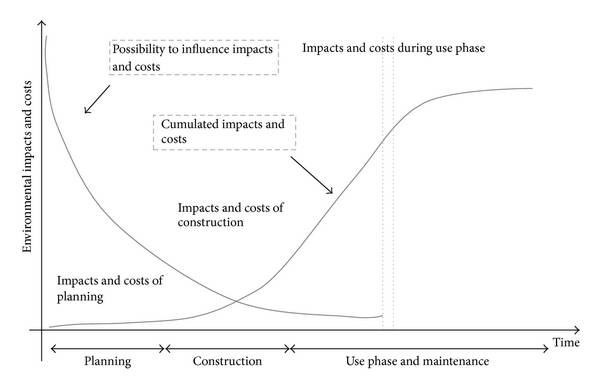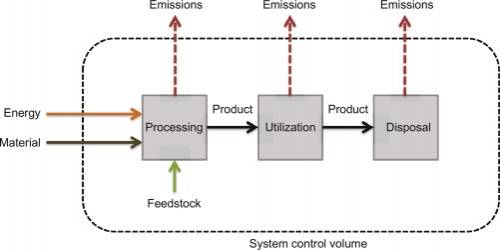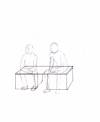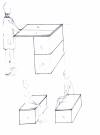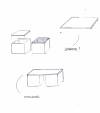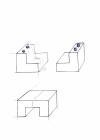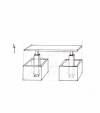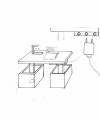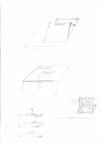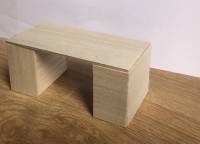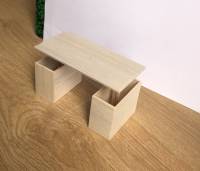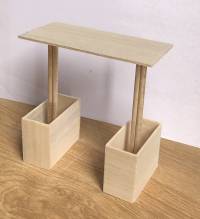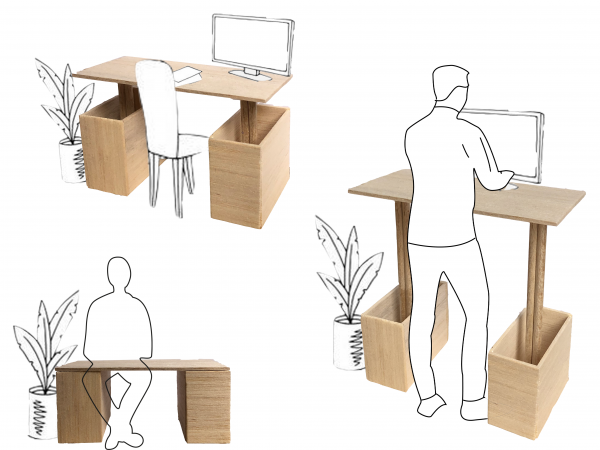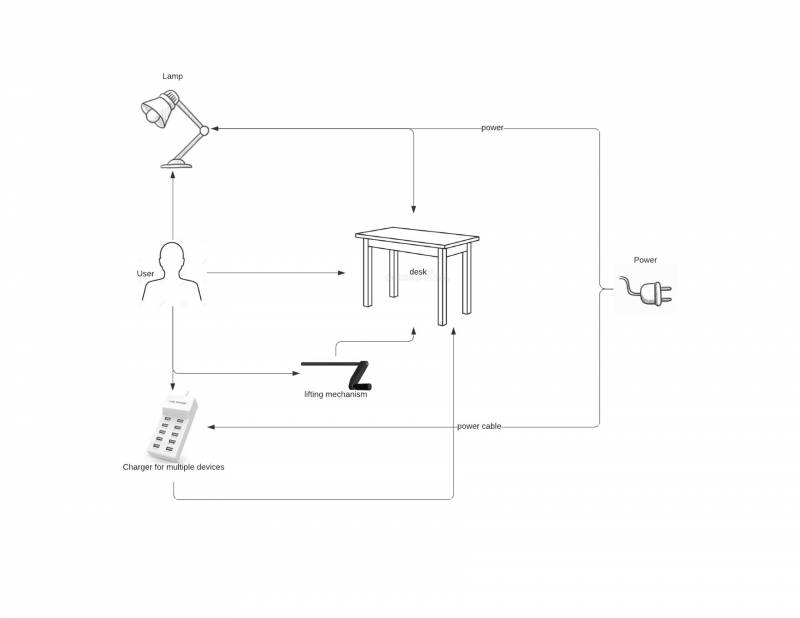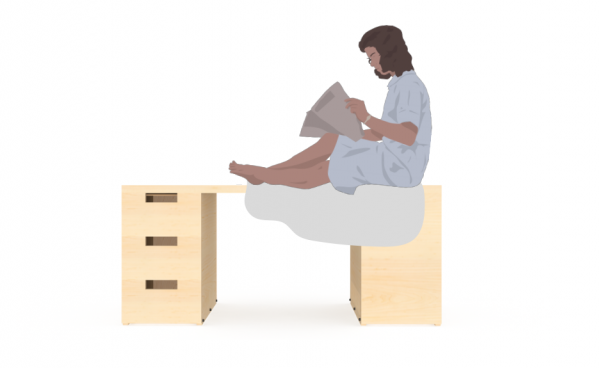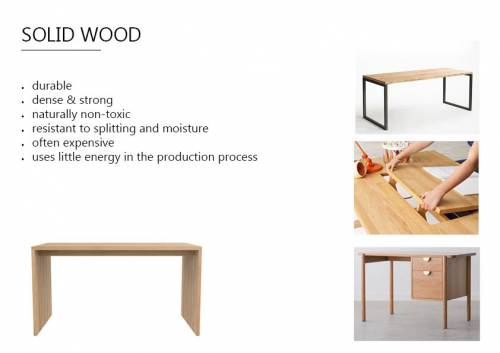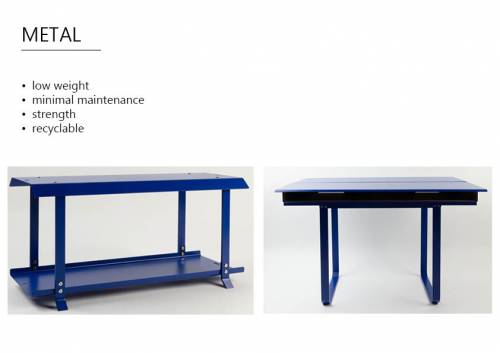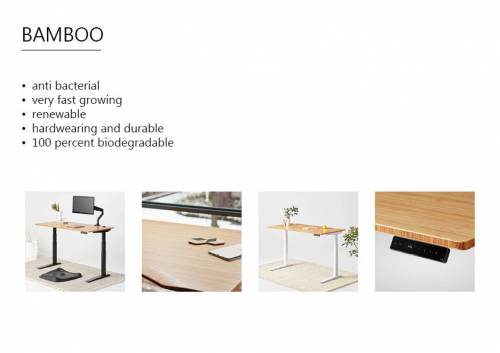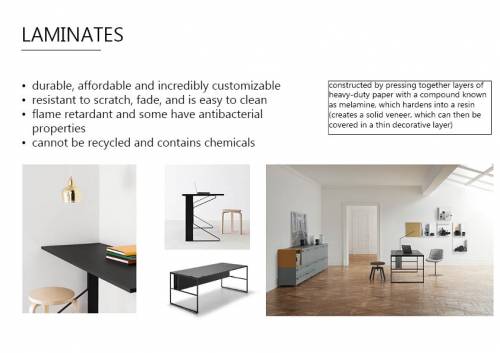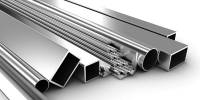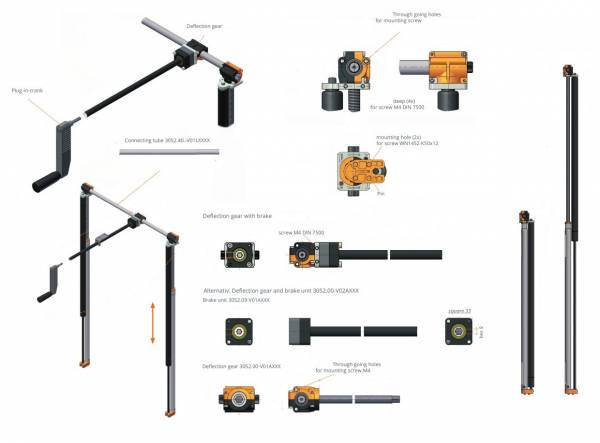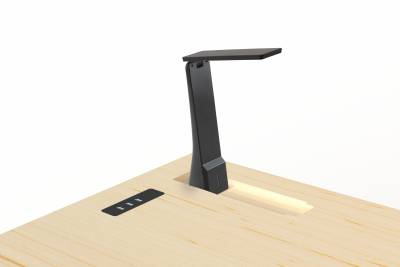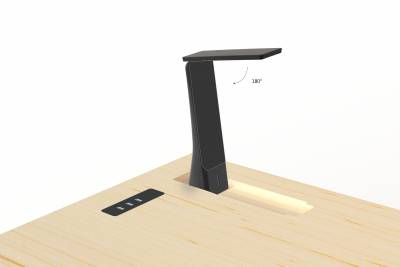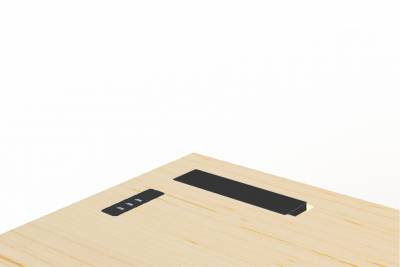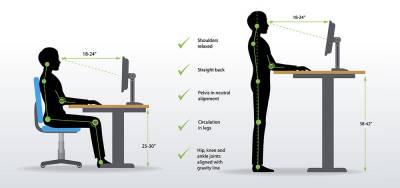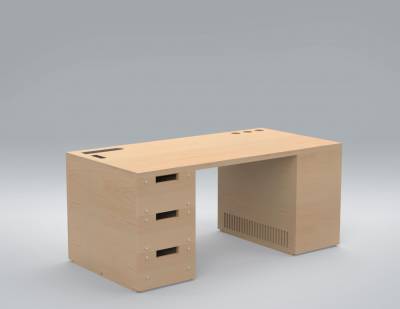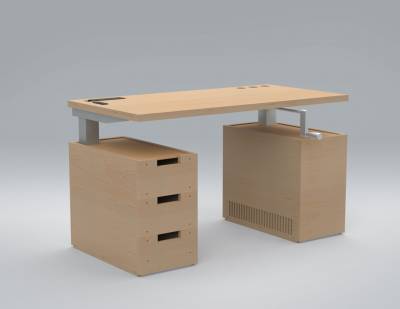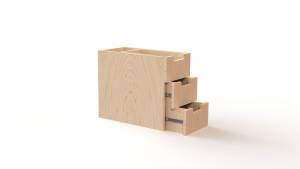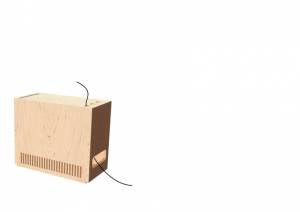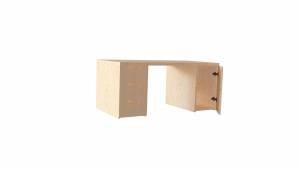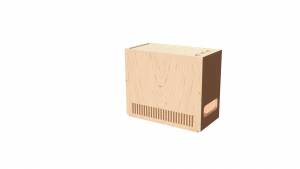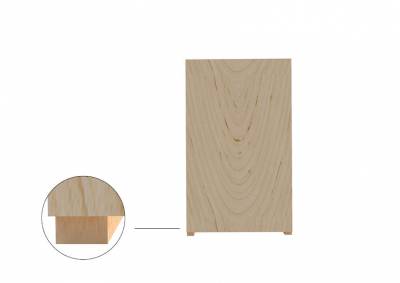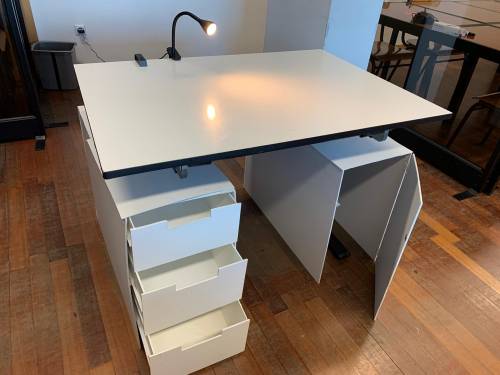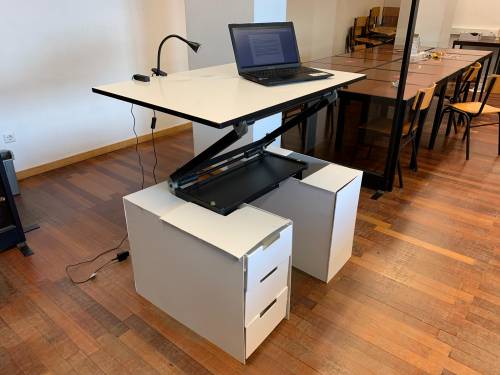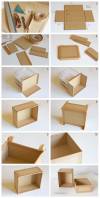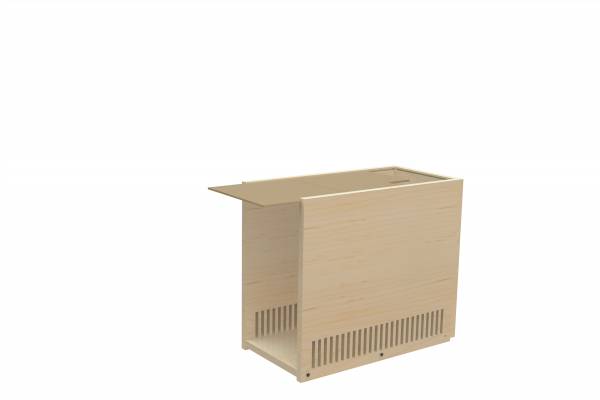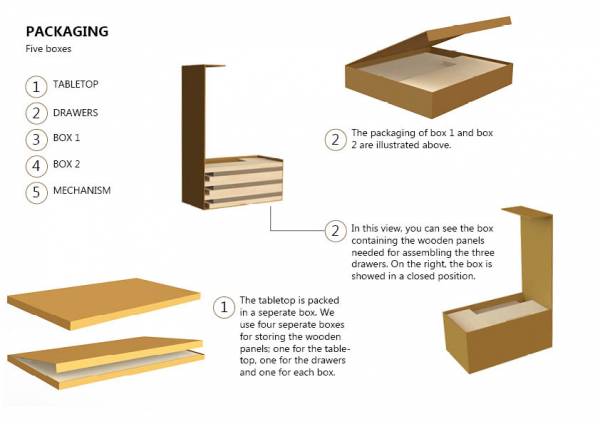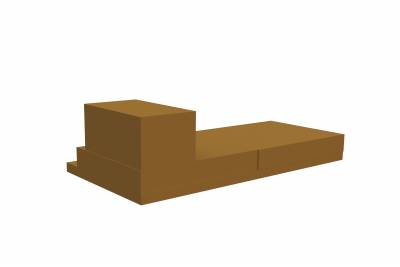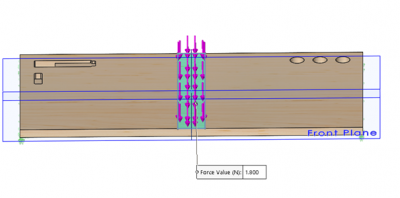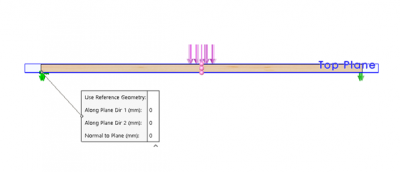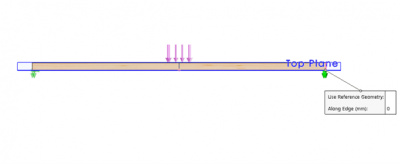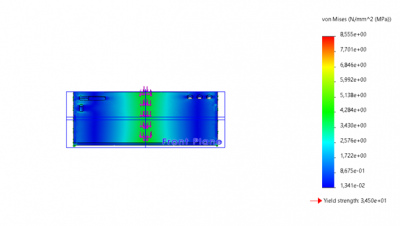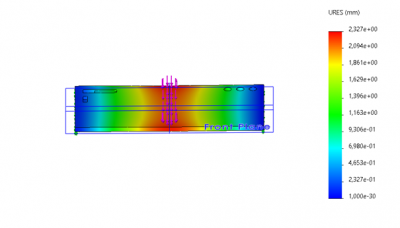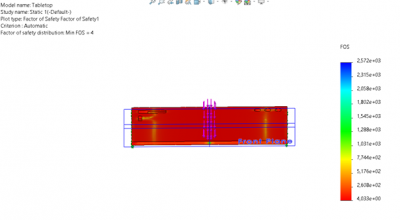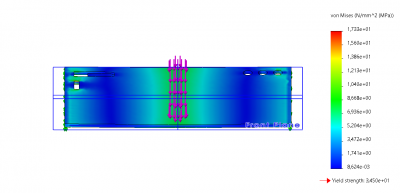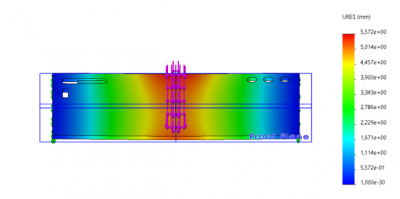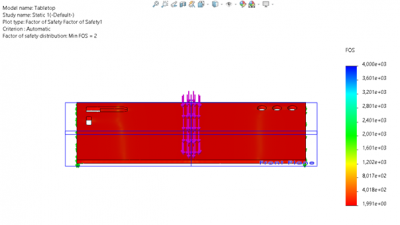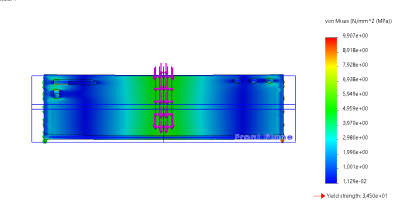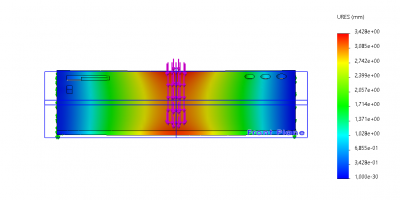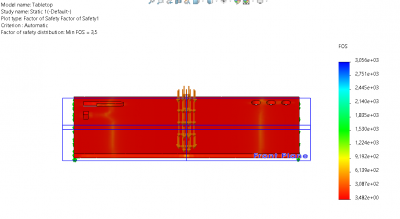Table of Contents
Ergonomic Reconfigurable Home-Desk | Report
FREE Home-Desk
Authors:
- Gabriel Nicoara
- Ioana-Silvia Carasel
- Anastasia Vandoorne-Feys
- Marcel Karpiak
- Nikola Kocheski
Acknowledgement
Our team would like to show appreciation to ISEP as well as the supervisors and teachers of the European Project Semester that have guided us through this project. We thank you for this opportunity to learn and grow, despite of challenges and setbacks. It has been a broadening experience for each member of team 3.
Glossary
| Abbreviation | Description |
|---|---|
| 2D | Two-dimensional |
| 3D | Three-dimensional |
| EOL | End-of-life |
| EPA | Environmental Protection Agency |
| EPS | European Project Semester |
| EU | European Union |
| ISEP | Instituto Superior de Engenharia do Porto |
| LCA | Life Cycle Analysis |
| MFC | Melamine Faced Chipboard |
| USB | Universal Serial Bus |
| WFH | Work From Home |
| WHO | World Health Organisation |
1. Introduction
Over the course of the 2021 spring semester, multiple students from different countries and backgrounds will participate in a program which is called the European Project Semester (EPS). The goal of this semester is to work together to develop a product. This report describes the work and progress of team 3 during these 5 months at Instituto Superior de Engenharia do Porto. In the following introduction chapter, we will introduce our team members and an overview of our project. After that follows a state of the art research, where we will look into ergonomics, working from home and different kinds of adjustable desks. The third chapter is dedicated to our management process, using SCRUM and Agile Project Management. The fourth one on marketing contains an analysis of the market and our target group, the chapter on sustainability discusses the environmental impact of our desk and the sixth one explores all ethical and deontological concerns relating to our product. The whole process of developing our product will be described in the seventh chapter; including sketches, a prototype, the product architecture, etc. … To summarize, we’ll conclude our insights and talk about possible future development.
1.1 Presentation
Our team is called team FREE, which stands for furniture that is reconfigurable and ergonomic and so refers to the subject that we have chosen. Team FREE is part of the European Project Semester (EPS) at Instituto Superior de Engenharia do Porto (ISEP). During the 2021 spring semester, this team will work together to develop a product which is a flexible home desk. The team consists of five students with different backgrounds, who each have their own set of characteristics, habits and skills. In Table 1, which is shown below, you can find information about the team members.
| Name | Country | Field of Study |
|---|---|---|
| George-Gabriel Nicoara | Romania | Industrial Design Engineering |
| Anastasia Vandoorne-Feys | Belgium | Product Development |
| Marcel Michał Karpiak | Poland | Mechanical Engineering and Applied Computer Science |
| Ioana-Silvia Carasel | Romania | Management & Information Technology |
| Nikola Kocheski | Macedonia | Computer Science and Engineering |
During this spring semester, we would each like to combine our individual knowledge and skills to reach our goal to the best of our abilities. Our team is presented down below, in figure 2. Marcel sadly couldn't be here for the photo because of the COVID-19 pandemic.
1.2 Motivation
Our team members are each highly motivated to participate in the EPS program. We think it would be very interesting to collaborate with students from other countries with different academic backgrounds! Learning to work together in a diverse team is incredibly important to us. In today's work environment, this is increasingly becoming the norm. We also thought it would be instructive to work in a different way than we're used to and to be able to focus on a single project for a longer period of time. Not to mention, we're eager to develop new skills; both language skills and skills that can be useful within our field of study. Finally, we hope to have some fun along the way!
1.3 Problem
Introduction
With our adjustable desk, we want to tackle two global issues; the shift to a working-from-home model and the decrease in the average living area. In light of the COVID-19 pandemic, businesses drastically shifted to a working-from-home model. This shift has become a policy priority for governments to reduce the number of infections. Many people, all over the world, had to convert their home into a workplace in no time. This drastic adjustment wasn’t easy on everyone, including for those who live quite small.
Reduced Living Area
A United Nations report stated that in 2018, 55% of the world’s population lived in urban areas. They expect this number to increase to 68% by 2050 [1]. “In most metropolises in the world, people’s average living area is getting smaller and smaller. More and more young people tend to move to large cities for more opportunities and more active life style. However, this phenomenon decreases the average living area gradually” [2]. According to a research by LABC Warranty, ‘the living rooms of newly built homes in Britain are nearly a third smaller than equivalent homes built in the 1970s [3].’ With more and more people living smaller, the adjustable furniture trend is increasing.
Working-from-home
“Before the pandemic, discussions on the future of work-life were unclear and often questioned. COVID-19 forced a decision upon people, and with the world having to adapt quickly, many businesses opted to try WFH. The WFH practices have been employed widely, as can be seen in the U.S., where studies show in May 2020, 35.2% of the workforce worked from home, an increase from 8.2% in February” [4]. Hundreds of millions of people have lived through lockdowns and periods of quarantine. More than a year after the World Health Organization declared Covid-19 a pandemic, a lot of people are still working remotely. At first, the shift to working-from-home was abrupt for many. In the meantime, this working-from-home model has been normalised because of the pandemic. The whole 9-to-5 model has been turned upside down and the lines between home and office are becoming more and more blurry, illustrated in Figure 3.
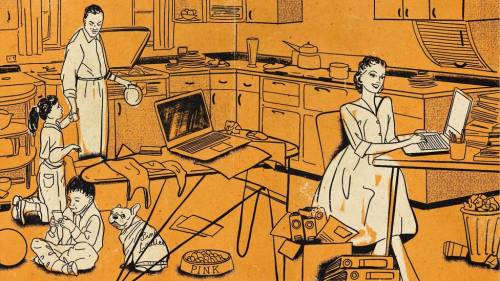
There are certain risks associated with working from home, specifically on the long term. These consequences, primarily related to health, should be considered by both employers and employees. “According to the Get Britain Standing organisation, a sedentary lifestyle is one of the four top causes of preventable death. From cardiovascular health and metabolism issues to mental health, back and neck pain, muscle degeneration and osteoporosis, a wide range of conditions can be caused or exacerbated by excessive amounts of time spent sitting down [6].” Constant sitting is a real problem when working from home. As mentioned before, the boundaries between work and life get more and more blurred. Some employees work way longer hours because the starting and stopping time is more unclear. They can start their work day long before the time they would normally enter the office and also finish later in order to finish their work. Going out for a coffee or lunch is getting replaced with taking ten steps to the kitchen. This all results in more sitting and less steps throughout the day.
We need to rethink the working environment for sedentary workers - and that's where standing desks come in. Remote workers should have a desk that enables them to sit or stand as they prefer.“Research and medical trials suggest that standing desks directly help to boost work performance and reduce the risks inherent in a sedentary lifestyle. In research published by the British Medical Journal (BMJ) in 2018, NHS staff who swapped their standard desks for sit-stand workstations reduced their sitting time by around 80 minutes per day after a year [7]. ”
Our way of working will probably never be the same, but how it will differ is still unclear. “A Future Forum research of 4,700 knowledge workers found the majority never want to go back to the old way of working. Only 12% want to return to full-time office work, and 72% want a hybrid remote-office model moving forward [8]”. A sitting to standing desk can be a solution for remote workers who are concerned about the consequences of reduced moving and increased sitting.
1.4 Objectives
The main objective of this project is to develop an adjustable home desk that enables the user to decide which position allows him/her best to focus. When not in use, the desk should be transformable into a bench so the user can rest or use it for different purposes. After analysing similar products on the market, we will design our own prototype. During this process, we must keep in mind the ethical and sustainable issues regarding our product. In the end, our product must meet the predetermined requirements and undergo the necessary tests.
1.5 Requirements
We’ve made up a list of requirements for our desk, that is shown in Table 2. At the beginning of the project we received a predetermined budget of 100 euros, which must be taken into account.
| 1 | Easily and electrically adjustable |
| 2 | Ensures an ergonomic posture |
| 3 | Ensures a comfortable position |
| 4 | Easy maintenance |
| 5 | Room for storage |
| 6 | Charging ports |
| 7 | Inclination angle |
| 8 | Built in desk lamp |
| 9 | Three possible heights |
1.6 Envisaged Tests
We’ll evaluate the desk by performing some functional tests. Our aim is to detect eventual problems related to the mechanism, components and materials. It’s of great importance to guarantee that our product is safe and works as promised. The following tests will be performed:
Structure test
We’ll test if the construction is strong enough to hold up to 2 people, taking into account a safety factor and P95 measurements. The lifting mechanism should also be subjected to a test to verify that is strong enough to hold the desk. All tests can be done in simulation software to simulate the forces which will be applied to the desk.
Usability test
We’ll verify if the lifting mechanism is easy to lift for the user and the time and effort this action takes. We will also test if the user can easily use the storage space, light and charging ports, without any risks. This test can’t be done in simulation software, we will need a working prototype.
Material test
Our materials must be durable and provide a good surface to work on. We should avoid any sharp edges by all costs. The material has to be strong enough to withstand the stress and pressure on it, this can be tested using simulation software. Further, it should be sustainable and the off-gassing of VOC’s should be kept to a minimum.
1.7 Report Structure
The report consists of eight chapters. Their names and contents are listed below, in Table 3.
| 1 | Introduction | A presentation of our team and our project. More precisely the problem we want to tackle, what we want to accomplish and how we plan to do this. |
| 2 | State of the Art | Presented here is our reseach. We looked into different kinds of transformable furniture and made a comparative table with existing desks. We also delved deeper into ergonomic furniture to support our design. Finally, we investigated the shift to working from home and its consequences. |
| 3 | Project Management | A report on our management process using SCRUM and Agile Project Management. |
| 4 | Marketing Plan | An analysis of the market and our target group followed by strategies to launch our product in that specific market. |
| 5 | Eco-efficiency Measures for Sustainability | An analysis of the impact our product has on the environment; focusing on the social, economic and environmental aspects. |
| 6 | Ethical and Deontological Concerns | An analysis of all ethical issues relating to our product and possible solutions. |
| 7 | Project Development | Specifications related to the product such as the different components, the product architecture, … Sketches and prototypes will also be shown here. |
| 8 | Conclusions | Summary of the report and possible future development. |
2. State of the Art
2.1 Introduction
The overall theme of our project is ergonomic reconfigurable furniture. Now, what does this actually mean? According to the Cambridge Dictionary, to reconfigure means ‘to change the structure or arrangement of something’. In the state of the art, we will discuss this term and some solutions related to it. We started off by looking at reconfigurable furniture in general but later, we mainly focused on adjustable desks. Further, we’ll be looking into ergonomics and the shift to working-from-home. More than a year after the WHO declared Covid-19 a pandemic, a lot of people are still working remotely. This shift was abrupt for many but has been normalised because of the pandemic, turning the whole 9-to-5 model upside down. There are certain risks associated with working from home, specifically on the long term. These consequences, primarily related to health, should be considered by both employers and employees. In the context of (home) offices, ergonomics is required rather than desired. By reading and analysing different papers and projects, we hope to gain a better insight into these problems and existing design solutions.
2.2 Transformable Furniture
Transformable furniture is designed based on the concept that the furniture’s design must involve at least two forms of appearance and function [9]. By having multiple functions, the furniture forms a solution for people with too little space. Transformable space-saving furniture is often innovative, has much opportunity for future development and a huge potential market in metropolises [10]. In this section, we're looking into some of the existing transformable furniture designs. We started looking into transformable furniture in general and then, when the scope of our product was definined, we focused mainly on adjustable desks.
FURNITURE IN GENERAL
Transformable bed
The most common example of this type of save-spacing furniture, may be a transformable bed. There are a lot of forms of tranformable sleeping spaces because beds take up a lot of space and don't have a lot of use during the day. Space saving beds can be divided into two categories, regular beds and bunk beds. The bed can be transformed into a different type of furniture (e.g.; a table, a couch, a desk, etc. …) and hereby helps owners to utilize their furniture efficiently. The most important function of this design is that it increases the available space of the room which makes is very helpful for people who live in small apartments. There are different ways to transform a bed; some beds are extendable and can be pulled out of some kind of storage space, others have the possibility to be mounted against the wall. Transformable beds can be quite expensive [11].
Transformable tables
Many tiny houses use transformable tables. These tables that can serve as a bar, desk, small coffee table, etc. … but have the possibility to expand into a large dining table. Sometimes the tables can be folded down from the wall, saving even more space. Some people build storage shelves on the wall against which the table is mounted, these are hidden when the table is folded and revealed when the table is in use.
Az desk and seat
The Az desk and seat by Guillaume Bouvet is designed with the life cycle of the user in mind, the furniture is suposed to grow with children. The vertical blackboard with a magnetic surface can be converted into an ergonomic work surface and be adapted to the user's size from young children to adults. The desk is made using birchwood ply panels providing a good stability and a solid aspect to the unit. This type of wood, from eco-managed forests in northern Europe, is known for its robustness; its texture, grain and natural colour stimulate the development of the child's senses. This project has been designed based on ecologically sustainable development principles [12].
N+L Convertible Series
FEIT designed a cradle for newborn babies that can transform into a drawing table and then a desk, as the child develops and grows. The Green Product Award writes that “The N+L convertible Series, consists of a cradle NINA, plus a table LUCA with a maxi drawing top and desk whose height can be adjusted thanks to its feet. A special feature are the natural materials used, like the solid wood for the frame, or the organic lambswool for the cradle sides and coconut fibre for the mattress filling. The average cradle has a lifespan of about 9 months, this piece of reconfigurable furniture provides a second use and therefore also a longer life of the product [13].
IKEA HACKA
Designer Philip Süssmann wants to respond to the fact that more and more people want to modify products to make them their own. The design is a frame system, made out of standard sized wooden beams and metal joints, which function as the main structure for kitchen appliances such as cabinets, surfaces and fittings. Due to the systems flexiblity and possiblity of hacking, it allows for custom sizes and third party objects, making it possible to cater for different needs in any environment [14]. The kitchen is really something you can make your own, what makes it more flexible and personal to the user.
DESKS
PROPR OFFICE
PROPR OFFICE IS a new name in the furniture space that delivers sit-to-stand adjustable desks in an array of sizes for whatever space constraint you may have. This adjustable height desk is powered by “smooth, nearly silent” electric lifters. The desk features a durable and commercial quality laminate top that is easy to clean and disinfect. The two steel legs at the base are powered by dual motor lifters that operate under 50 decibels. There are two versions available; Prch Adjustable Height Desk 48“ wide x 24” deep and 42“ wide x 24” deep. They both weigh approximately 130 lbs [15].
Jaswig StandUp Nomad
Using standing desks is a great way to incorporate a bit more activity into ones workaday life, which is much needed during this pandemic. “The Jaswig StandUp Nomad is a wooden standing desk that is adjustable, made locally with eco-friendly materials, and, most importantly, a pretty piece of furniture [16].“ The desk is 100% manufactured in the United States, using eco-friendly materials namely, sustainably-grown, Forest Stewardship Council-certified birch plywood. The Jaswig StandUp Nomad can be assembled tool-free in under 15 minutes. The desk is easy to move around due to its compact design, which makes it a very flexible home desk. On top of that, an ergonomic footrest provides comfort and assists with weight distribution. There’s even room for storage beneath the tabletop. There are nine different height settings, that can be adjusted manually; starting from 93cm minimum up to 122cm maximum. The tabletop is available in a regular and a wide size. The desk also has a kids version available starting from 250 € a desk, the wide version can go up to 420 € [17].
Modular desk
This desk concept from French design student Francois Dransart consist of built-in interchangeable modules for organising specific desktop items. With this design Dransart wants to address the problem of office clutter. “It features a slim oak top with rectangular slots that hold completely flush-fitted storage boxes – for paper, pens, wires, plug outlets, and other items – plus a headphone stand, an LED lamp and an induction charging plate [18].”
On top of of the white plastic storage boxes, there are small brown leather tabs for lifting them out of the desk. On the front of the desk there’s a grey felt tab for comfort, and on the back there’s one for holding wires. The slender frame is intended to be made from bent steel, coated white to match the boxes. [19]
Unplugged
Unplugged is a thesis project of Swedish student Eddi Törnberg. The idea behind this energy producing workspace came from the belief that society as a whole lacks “the will, interest and energy to struggle to achieve a sustainable society.” Törnberg tried derive energy from things we already do. “Unplugged is an office that facilitates producing the energy needed to run all of our office electronics through doing everyday activities.” In this design, he incorporated three techniques to produce energy: piezoelectricity from the carpet, the chair utilizing the Seebeck effect, and the flower through photosynthesis [20].
SIT-STAND DESK
This sit-stand desk from MATEO GOODS aspires to make the working environment both inspiring as functional. This adjustable height desk with 2 felt-lined drawers and integrated wire management comes with 3 power modules with USB charging ports. The desk is made out of resilient materials, including solid Baltic Birch with a focus on eliminating waste and ensuring durability. With the help of electronic height adjustment, the desk rises and falls through a simple push button. The desks have a built-in wire management system that hides unsightly wires and accounts for just how many devices we have in our lives. It contains a whole suite of accessories and is therefore fully customizable to suit your every need. The design includes secondary surfaces that help hide clutter and allow you to enjoy your office spaces [21].
BEKANT DESK IKEA
“This robust desk is guaranteed to withstand years of coffee drinking and hard work. By alternating sitting and standing, your body stays in motion so that you feel better and perform better. The height of the work surface is electrically adjustable from 65-125 cm, giving you an ergonomic working position. With the cord net under the tabletop, you can easily keep your desk neat and tidy. A melamine tabletop is wear-resistant, stain-resistant and easy to keep clean. The depth of the desktop provides ample workspace and a comfortable distance from the display. By using saw residues and wrecking wood in the chipboard of this product, IKEA uses the whole tree and not just the trunk. This desk has been tested for office use and meets the requirements for durability and stability according to standards: EN 527-2 and ANSI/BIFMA X5.5 [22].
YAASA DESK
The YAASA Desk Basic is designed to be adjusted to the perfect height in a fast, intuitive and effortless way. The heigh can be adjusted from 71 to 120 cm. The hand switch is located beneath the tabletop, and can be mounted in different positions according to your preferences (e.g. if you are left-handed). The desk guarantees seamless transitions with optimum drive dynamics through integrated high-performance motors. At just 32 kg, the YAASA Desk Basic is a lightweight champion on the market for height-adjustable desks. There are no compromises on stability or quality, while simplicity makes assembly quick and easy. On top of that, the desk is robust and easy to assemble [23].
VIVO
VIVO has a wide range of electrical height adjustable desks. The DESK-KIT-2E1B is one of their bestsellers, which we chose to analyse. The desk uses built in cable management for a clean and organized appearance [24]. It contains a timer that reminds you to stand up throughout the day. Using three memory presets, you can easily remember your ideal height. The desk can hold 77kg and the height can be adjusted between 75 and 126cm. These last two numbers can differ according to the specific desk you buy from VIVO.
Allcam Desk
Just like VIVO, Allcam has quite a range of sit-to-stand desks. We analysed the Allcam Desk EDF21SS, one of their ergonomic height adjustable sit-stand des. The height can be adjusted between 73.5 and 123.5cm, with a simple 2-button remote. The desk is innovating because the motor and controller are merged into one module, which results in a more reliable product at a reduced cost [25]. The construction is made out of steel and can bear a load of 60kg. The desktop is made out of MFC and has a compact size of 120×80 cm. The whole desk is flatpacked and according to Allcam, you should be able to finish the assembly in 10mins.
PrimeCables®
We analysed the PrimeCables® Sit-Stand Dual-Motor Height Adjustable ADR Desk. The company calls this desk “a minimalistic option and the best standup desk if you want something without frills or high costs, perfect for offices, schools, homes and most working environments” (PrimeCables®). The desk contains 3 programmable height memory presets. It has an adjustable width range from 110 to 180cm. The height is adjustable between 62 and 125cm. The desk can carry a load up to 124kg. They claim that the range fits almost everyone but after reading some reviews, this doesn’t seem to be right. Some people claim that the shortest position is still way too high. On top of that, multiple reviews state that the desk is quite wobbly.
Table 4 summarizes all the commercial desks, and their features, mentioned above.
2.3 Ergonomic Furniture
Ergonomic, as Cambridge Dictionary defines the term, “is relating to the design of furniture or equipment which makes it comfortable and effective for people who use it”. Another two definitions are given by Merriam-Webster Dictionary: “ 1: an applied science concerned with designing and arranging things people use so that the people and things interact most efficiently and safely; 2: the design characteristics of an object resulting especially from the application of the science of ergonomics”.
As scientific literature mentions, ergonomics is a scientific discipline that studies the relationships between humans and other system components. It is also a field of study that uses theory, concepts, data, and methods to improve human well-being and overall system efficiency by design. The term ergonomics is derived from the Greek words “ergon” (work) and “nomos” (laws). It's basically the “work rules” or “work science.” Good ergonomic design reduces incompatibilities between human and their working space, resulting in the perfect working environment.
Ergonomic furniture has the ability to adapt to the individual requirements of the user to ensure good posture. This type of furniture is specifically designed to function in harmony with the shape and natural curvature of the human body so as to ensure maximum comfort and overall wellness of the user. Ergonomic furniture is recommended in areas like the home office and offices where one tends to spend a lot of time sitting in one place [26].
Ergonomic school chair with adjustable parts
An ergonomic chair with adjustable parts was designed to achieve a good match between the anthropometric characteristics of students and the furniture they use. Anthropometry is defined as measuring dimensions of the body, including body size, shape, strength, capacity, and volume for designing aims. A large number of studies, worldwide, have shown a mismatch between students’ anthropometric characteristics and dimensions of classroom furniture. Studies have shown that inappropriate design of chairs and their disproportion with body dimensions in the long-term not only influences physical growth, poor postures, and musculoskeletal disorders, yet also decreases student’s learning interest, even during the most stimulating and interesting lessons, and indirectly affects educational efficiency and focus [27].
The chair designed and developed in this study was ergonomic and helped to reduce musculoskeletal disorders in students. Some ergonomic characteristics of this chair included adjustability of footrest, backrest, armrests, and desk and these factors led to the use of this chair by many students with different body sizes. The edges of the seat had a curvature that prevented pressure to different parts of the body and created comfort for users. Other advantages of this chair that distinguished it from other educational chairs include adjustable footrest so that legs can be fully fitted, adjustable height of the desk and left armrest, desk rotation in two axes of X and Y, adjustability of the angle between the backrest and seat in four degrees, the large surface of the desk, grooves on the backrest to place bags, a groove on the desk to place pens and pencils [28].
Classroom furniture with proper anthropometric measures for primary school
The aim of this study was to compare the dimensions of students to the dimensions of school furniture in primary school to see if this form of furniture is well-designed and encourages good sitting posture at school by taking the children's dimensions into account. The data reveal a discrepancy between the physical measurements of the students and the classroom furniture they normally use. The seats are too high and too deep, and the desks are also too high. This situation has a negative impact on children's sitting posture, especially while reading and writing. The study proposes adjustable furniture as a solution, due to the fact that a range of furniture sizes from which students can pick the correct one at the start of the school year is unlikely to be financially feasible [29].
Dynamic office chairs and their impact upon muscle activation, physical activity and posture
Studies in the literature show that repeated and static sitting postures at visual display unit workplaces cause physical inactivity and are risk factors for the musculoskeletal system. The aim of the present study was to evaluate the effects of four specific dynamic chairs on spine, postures angles and physical activity intensity, compared to those of a conventional standard office chair. All chairs were fitted with sensors that measured chair parameters (backrest inclination, forward and sideward seat pan inclination) and were tested by 10 subjects performing a number of office tasks, as well as in the field by another 12 subjects doing their daily office work. There were almost no noticeable variations in muscle activation, postures angles, and physical activity during the execution of traditional office tasks when comparing the four different dynamic office chairs with a typical one. The study's findings highlight the importance of considering multiple aspects of workplace design, such as tasks variability and other elements in the working space, other than the chair, in order to reduce physical inactivity at visual display unit workplaces and musculoskeletal disorders [30].
Design and analysis of an ergonomic-automated adjustable drafting table
The majority of young adults nowadays have a daily job that requires them to sit at a table or at a desk. As a result, they experience pressure, back and neck pain, because the table's dimensions are incompatible with their body dimensions. Based on the anthropometric data of a random sample of students, the goal of this study was to design an ergonomic-automated adjustable drafting table. The product was tested among the target group and, as a result, students prefer the proposed design to the current fixed one since it has an adjustable height, width, and desktop inclination with an automatic mechanism. The proposed desk aims to assist in the prevalence of musculoskeletal disorders, as well as provide users with safety, comfort and adaptability [31].
The ups and downs of sit-stand desks
This study is a complex review that examines the effects of sit-stand desks on six domains: behaviour (e.g. time spent sitting and standing), physiological, work performance, psychological, discomfort, and posture. It concludes that while sit-stand desks may change the user’s behaviour, they only have a minor impact on health outcomes. It has also been identified that sit-stand desks are most effective for reducing discomfort and least effective for increasing productivity. Despite this, further research is required to investigate long-term effects and assess clinically appropriate dosage and workstation configuration [32].
2.4 Working From Home
The pandemic situation changed the way of work all around the globe. Following sanitary restrictions, companies started to move towards remote work. At first for most of the society it was an obstacle, as many wasn't so efficient when it comes to operating with computers and so on. But as the time went by, people started to get used to it. Many companies started thinking that some of the tasks can not necessarily be done stationary. This article shows why working from home will be a thing in a near future and possibly will stay with us for a long time.
COVID-19 forced workers and firms to experiment with working from home, helping overcome inertia.
The pandemic situation forced some companies and workers to experiment with remote work, a technology they previously had access to but not tried out due to inertia. Prior to COVID-19 they operated on on business premises, with the payoffs of this strategy coming from a known distribution. At the same time firms had access to a second technology — working from home — which they could try out at some fixed cost. Once COVID-19 arrived it forces firms to all pay the cost of trying out working from home. This is also a learning opportunity. The survey showed that more than 60% of workers confirmed that the remote work turned out better as they expected it to be.
Workers and firms have made investments enabling working from home that will remain after the pandemic
The sudden shift to working remotely seen in 2020 spurred workers and firms to invest in physical and human capital to help them work from home effectively. Millions of people learned to use teleconferencing software and many others faced incentives to purchase desks, chairs, microphones, etc., to help them work from home more effectively. These investments will remain after the pandemic and will thus lower the marginal cost of working from home after the pandemic. Thus, they will enable the persistence of working from home.
Stigma associated with working from home has diminished during COVID
As said before, working from home at first had a pretty negative reputation. In particular, the view is that employees “shirk” instead of work on days when they are not in the office. In the survey, a major question was asked - how have perceptions about working from home changed among people you know? Responses to this question indicate that two-thirds of Americans report perceptions of working from home have improved among people they know. Only a small number — 6.1 percent—say perceptions have worsened. Furthermore it shows that employee preferences and employer plans for post-pandemic working from home are both higher among respondents who report more widespread improvements in perceptions of working from home.
Innovation to improve working from home
Technological advances and investments enabling working from home will help workers and firms to shift to working from home and provide incentives for others to create and further implement new technologies and conduct further investments. Implementation of these innovations leads to more working from home and more investment in the networks that support it, such as physical communication networks and common knowledge of popular collaboration platforms like Zoom and Microsoft Teams. Greater working from home in turn creates demand for new technologies and further investments [33].
Effects on working from home in pandemic times
From the beginning of the 2020 the world had to face one of the biggest challenges of the century – the COVID-19 pandemic. According to a study made by the Department of Health and Human Development of University of Pittsburgh, working on a regular basis at home on your personal desk – when pandemic restrictions requires everyone to stay as much as possible at home – can negatively influence your lifestyle, as shown in the list below.
- Sedentary behavior increased with 1.3h in a non-working day;
- Sleep quality decreased – wake time delayed up to 40 minutes;
- Mood disturbances;
- Decreased concentration on work-related tasks;
- Stress.
These results had more impact on those who have changed their work environment into remote work. As a conclusion to this article, employees need to understand what working from home means for their lifestyle and also employers have to support desk-workers during pandemic restrictions, otherwise the performance of their work will decrease over time [34].
2.5 Summary
Several experts have stated that sitting behind your desk all day is bad for your health. This pandemic has brought more and more people to move less and less. Research shows that working from home can decrease sleep quality and concentration, cause mood disturbances and stress and increases the sedentary behaviour. We want to redefine the work environment at home, because it seems like this working-from-home model isn’t going anywhere.
We’re designing a sit-to-stand desk, that enables the user to define which position allows him best to focus. The desk starts of as a bench, providing a sense of comfort. It can be transformed into a sitting desk, and eventually a standing desk. Our aim is to keep the design simple but functional and ergonomic. We want to make the work environment comfortable and flexible. When staying at home most of the day, it’s important to create a sense of comfort. At the same time, it’s important to have a clean working space; after all, your office is also your home.
After thoroughly looking into different existing desks on the market, papers on ergonomics and the working-from home models, we’ve come up with a list of features that we should integrate into our own design. It speaks for itself that ergonomics is one of them. Considering desks nowadays, and especially home-desks, ergonomics are required rather than desired. In terms of the sitting-to-standing desk, the height should range from 50cm, the bench height, to 120cm to provide an ergonomic working position to all. Most of the desk are electrically adjustable, this makes it easier for the user. In the YAASA desk [35] the hand switch is located beneath the tabletop, and can be mounted in different positions according to your preferences (e.g. if you are left-handed). This is a possibility we could consider. An integrated wire management is something we’d like to integrate to keep the working area organised. For the same reason, storage space should also be included. A lot of the desks mentioned above don’t have any room for storage. A feature we want the desk to have is power modules with USB charging ports to charge all the users devices.
Organization is extremely important to bring this project to a successful conclusion. In the next chapter, we will go into more detail on how we handle this.
.
3. Project Management
The project was coordinated according to Agile project management, using Scrum methodology.
Agile project management is an incremental method to project delivery that takes place across the course of the project's life cycle. An agile or iterative strategy seeks to deliver benefits throughout the process rather than just at the conclusion. Trust, adaptability, empowerment, and cooperation should all be fundamental principles and behaviors in agile projects [36].
Scrum is a subset of Agile. It is a lightweight process framework for agile development and the most widely-used one. “Scrum addresses the complexity of software development projects by implementing the inspection, adaptation, and visibility requirements of empirical process control with a set of simple practices and rules.” [37].
3.1 Scope
The scope of the project is determined by the scope of the product. To describe the project scope, it is important to first understand the product scope.
According to the PMBOK Guide, 6th edition:
- “The project scope is the work performed to deliver a product, service, or result with the specified features and functions”;
- “The product scope is the features and functions that characterize a product, service or result” [38].
Summarizing the notions, we can refer to the project scope as the work needed to deliver the product (the “how”), and for the product scope as the total number of features and functional requirements of the product (the “what”).
The project's WBS (or Work Breakdown Structure), describes both the product and project scope.
Product scope: This project will consist of creating an innovative, reconfigurable desk that transforms into a bench. The project will be completed by June 2021. For providing ergonomy, there will be a system integrated into the product, that will facilitate the movability of the desk’s tabletop, transforming it into a bench, sitting desk, and standing desk. Furthermore, the tabletop will be inclinable and will have an integrated lamp. The product will also include an integrated battery with specific ports, having its own autonomy without a source of electricity nearby.
Deliverables:
- Research and State of the Art analysis
- Design and ideation: System Diagrams & Structural Drafts, System Schematics & Structural Drawings, Cardboard model
- Prototype
- Functional tests
- Final Report, Presentation, Video, Paper, Poster, and Manual
Project scope: The work to be done in order to build the product: planning, project management, risk management, material procurement, engineering the necessary system for the implementation of the features.
3.2 Time
Based on the work plan with deadlines and deliverables, we created the Gantt Chart as presented below, according to the product backlog.
The Gantt Chart represents the user stories, and each user story is part of an epic (for which we assigned a specific color).
EPICS LEGEND:
- E1: Weekly classes - in green
- E2: Final report - in orange
- E3: Solution design - in pink
- E4: Prototype - in blue
- E5: Website - in red
The project plan, including the Gantt Chart, is created based on the urgency of deliverables, the Interim Report representing a key milestone. For a comprehensible representation, the Gantt Chart doesn’t contain all the subtask that divide from each user story. The Weekly classes and Final report are the recurrent activities, and the team allocates time for them during every stage.
KEY MILESTONES:
- State-of-the-art research
- Deciding upon the solution (product’s scope and specifications)
- Interim report & presentation
- 3D Model
- Final report & presentation
3.3 Cost
There are different forms of costs in project management:
- direct costs, like fixed labor, materials, and equipment;
- indirect costs, like utilities [39].
During the second phase of our project, we focused on the implementation process and gathered a wider overview in order to forecast the costs. This section will present in more detail the direct costs that concern the human resources and the materials used.
3.3.1 Human Resources:
Cost management usually includes the labor costs, which play a significant role in the total cost of a product. The costs must be determined by management, and it requires a proper strategy in order to maintain the labor cost of the product as low as possible, for the desired quality.
For this project, we don’t include labor costs into the cost of the final product as this is an academic project and not a professional activity.
The estimated labor costs presented in Table 5 are presented as an example of how things would have been analyzed in a company, considering the average monthly salary in Portugal for engineers who have already started working in their field of study, based on some estimations gathered from the market.
| Nr. Crt. | Name | Salary/Month [€] | Cost/3 Months[€] |
|---|---|---|---|
| 1. | Gabriel | 1000 € | 3000 € |
| 2. | Silvia | 1000 € | 3000 € |
| 3. | Anastasia | 1000 € | 3000 € |
| 4. | Nikola | 1000 € | 3000 € |
| 5. | Marcel | 1000 € | 3000 € |
| Total cost: | 15000 € | ||
*The effective labor costs, SS, FCT, and any kind of taxes are not taken into account.
3.3.2 Material Resources:
In Table 6 are displayed the material resources needed and the costs to build the FREE Desk.
| Nr. Crt. | Item | Part of the FREE Desk | Provider | Dimensions | Quantity | Unit | Unit Price [€] | Total Cost [€] |
|---|---|---|---|---|---|---|---|---|
| 1. | Solid maple wood plate | Table top, Box 1&2 | Vitra | 1 m² (3cm thickness); 3.5 m² (2cm thickness) | 1; 3.5 | m² | to be negotiated based on quantity (€/m²) *approximately 7 €/m² | 31.5 € |
| 2. | Aluminium profiles | Legs, Support for table top, Support for boxes | Aluplasto | 60x2x6.5 mm; 30x2x6.5 mm | 1; 1 | items | 7 €; 5 € | 31 € |
| 3. | V1: Electrical lifting mechanism | Lifting Mechanism | Flexispot | 1125x530x70 | 1 | items | 200 € | 200 € |
| V2: Crank lifting mechanism | Lifting Mechanism | Ketterer | 1125x570x50 | 1 | items | 150 € | 150 € | |
| V3: Sliding Mechanism with Lock Pin | Lifting Mechanism | Amazon | 1125x500x425 | 1 | items | 100 € | 100 € | |
| 4. | Drawer runner | Box | Leroy Merlin | 500×45 mm | 6 (3 pairs) | items | 17.89 € | 107.34 € |
| 5. | Full overlay hinge | Box | Leroy Merlin | 20×60 mm | 2 | items | 1.19 € | 2.38 € |
| 6. | Cabinet drawer push open system | Box | Leroy Merlin | 14x15x114 mm | 1 | items | 7.99 € | 7.99 € |
| 7. | Carbon Steel, Hexagon Threaded Insert Nuts | Box | Fruugo | M6x17 mm | 20 | items | 19.95 € / 20 items | 19.95 € |
| 8. | Screws 7mm | Box | Leroy Merlin | 5×70 mm | 40 | items | 0.10 € | 4 € |
| 9. | Screws 2mm | Box | Leroy Merlin | 5×20 mm | 40 | items | 0.10 € | 4 € |
| 10. | Black Hub 3 Outputs | Tabel top | Aquario | 8x46x28 mm | 1 | items | 8.65 € | 8.65 € |
| 11. | Cable organiser | Box (wire management) | Accezz | 82x20x14 mm | 1 | items | 2.90 € | 2.90 € |
| 12. | Lamp | Table top | Polegada | 200x50x260 | 1 | items | 26.57 € | 26.57 € |
| 13. | Face grain plugs | Boxes (cover screws) | Leroy Merlin | - | 20 | items | 0.75 | 15 € |
| Total cost: | 461.28 € (Electrical lifting mechanism); 411.28 € (Crank lifting mechanism); 361.28 € (Sliding Mechanism with Lock Pin) | |||||||
The prototype is built on a 1:1 scale, but using recycled materials, just for the proof of concept. The prototype doesn’t incorporate the proposed mechanism and the wood. Instead, for representing the boxes we used PVC, with the advantage that the material is easy to handle, and for the desk’s legs and tabletop, an old desk was used.
Other materials that our team used for the prototype are represented in Table 7.
| Nr. Crt. | Item | Part of the FREE Desk | Provider | Dimensions | Quantity | Unit | Unit Price [€] | Total Cost [€] |
|---|---|---|---|---|---|---|---|---|
| 1. | PVC glue | Box | Leroy Merlin | - | 1 | items | 8 € | 8 € |
| 2. | PVC cutting board | Box | Staples | - | 1 | items | 15 € | 15 € |
| 3. | Hinges | Box | Leroy Merlin | - | 2 | items | 3 € | 6 € |
| 4. | Kit Push to open | Box | Leroy Merlin | - | 1 | items | 8 € | 8 € |
| 5. | Charging port | Desk | Ikea | - | 1 | items | 14 € | 14 € |
| 6. | Lamp | Desk | Ikea | - | 1 | items | 15 € | 15 € |
| 7. | Arduino kit | Lamp | provided by ISEP | - | 1 | items | 12.5 € | 12.5 € |
| 8. | LDR | Lamp | provided by ISEP | - | 1 | items | 4 € | 4 € |
| 9. | LED | Lamp | provided by ISEP | - | 1 | items | 1 € | 1 € |
| 10. | NE 555 | Lamp | provided by ISEP | - | 1 | items | 0.5 € | 0.5 € |
| 11. | Current booster | Lamp | provided by ISEP | - | 1 | items | 9 € | 9 € |
| 12. | Resistor | Lamp | provided by ISEP | - | 1 | items | 5 € | 5 € |
| Total cost: | 98 € | |||||||
3.4 Quality
The following KPIs have been created for the FREE desk based on user’s needs, internal process standards, and project standards.
| Nr. Crt. | Metric | Standard | Frequency | Report |
|---|---|---|---|---|
| 1. | Durability/ Strength | >15 years | Per prototype | Monthly Quality Management Review (QMR) |
| 2. | Max Weight | 200 kg bench position 40 kg load when lifting | Per prototype | Monthly Quality Management Review (QMR) |
| 3. | MTBF | ~6.5 | Per prototype | Monthly Quality Management Review (QMR) |
| 4. | Lifting Mechanism - Defect Rate | < 1 out of 500 | Per production of 500 tools | As achieved |
| 5. | Sensor LED Lamp Lifespan | minimum 25,000 hours | Per prototype | Monthly Quality Management Review (QMR) |
| 6. | Battery Life Cycle | minimum 800 discharge/charge cycles | Per prototype | Monthly Quality Management Review (QMR) |
| 7. | Materials Reusability | < 1% based on total material used per tool | Per prototype | Monthly Quality Management Review (QMR) |
| 8. | Customer Satisfaction: comfort, ergonomic functionality, adjustability, aesthetics | 7/10 or higher with no individual score below 6 | Per prototype | Monthly Quality Management Review (QMR) |
3.5 People
Successful projects are generally the product of rigorous planning, as well as the expertise and cooperation of the project's team members. Without each of their key team members, projects can't move forward.
The project team members are the individuals who primarily work on one or more stages of the project. In our project, the team members’ roles can vary depending on the different stages of the project.
Overall responsibilities of team members:
- Contribute to overall project objectives;
- Complete individual deliverables;
- Provide expertise;
- Work with users to determine and meet business needs;
- Document the process [40].
The advisory committee consists of the teachers that evaluate project deliverables and coach the team. Throughout the project, they secure resources for our team, approve the project's proposed changes, budget, or schedule.
In project management, the Responsibility Assignment Matrix (RAM), also known as RACI matrix, lists all of the roles among the team and their active participation in a project. A RACI matrix guarantees that all partners are aware of who is in charge of performing tasks or receiving input on deliverables.
The RAM Matrix for our project is presented below:
| Activity Description | Gabriel | Silvia | Anastasia | Nikola | Marcel | Supervisors |
|---|---|---|---|---|---|---|
| Brainstorming and Task Allocation | R | A | R | R | R | C/I |
| Project Backlog | R | A | R | R | R | C/I |
| Global Sprint Plan | R | A | R | R | R | C/I |
| Gantt Chart | C/I | A/R | C/I | C/I | C/I | C/I |
| State of the Art | R | A | A | R | R | C/I |
| Technical Research | A | R | R | R | R | C/I |
| Black Box Diagrams | A/R | C/I | C/I | A/R | C/I | C/I |
| System Diagrams & Structural Drawings | R | C/I | A | R | C/I | C/I |
| Marketing Analysis | A/R | A/R | C/I | C/I | C/I | C/I |
| Eco-efficiency Measures for Sustainability | C/I | C/I | A/R | C/I | C/I | C/I |
| Ethical and Deontological Concerns | C/I | C/I | C/I | C/I | A/R | C/I |
| Project Development | R | A/R | R | R | R | C/I |
| Project Management Analysis | C/I | A/R | C/I | C/I | C/I | C/I |
| List of Materials | C/I | C/I | C/I | A/R | C/I | C/I |
| Brand design: Logo, Flyer, Leaflet | R | R | A/R | R | R | C/I |
| Website | C/I | C/I | C/I | A | C/I | C/I |
| 3D Model | A/R | C/I | A/R | C/I | C/I | C/I |
| Prototype | R | R | R | A/R | R | C/I |
| Paper | C/I | A/R | C/I | C/I | C/I | C/I |
| Poster | C/I | R | A/R | C/I | C/I | C/I |
| Video | A/R | A/R | A/R | A/R | A/R | C/I |
| User Manual | A/R | A/R | A/R | A/R | A/R | C/I |
| Final Presentation | A/R | A/R | A/R | A/R | A/R | C/I |
Table legend:
- R: responsible (the person who works on the specific task)
- A: accountable (the coordinator of the activity, the one who approves task and takes responsibility for the final outcome)
- C: consulted (the persons who opinion about the task, the expert whose opinion is relevant on the specific subject - mostly the teachers)
- I: informed (the person who will be kept up-to-date regarding the outcome of the task)
3.6 Communications
In project management, communication is essential. There are a lot of examples from projects that have struggled as a result of miscommunication and communication discrepancies. An effective communication process would facilitate communication between team members, as well as with the supervisors, and other project stakeholders.
Communication Methods:
- Meetings (online and in-person);
- Team’s Private Chat (WhatsApp group for instant messaging);
- Email (mostly with teachers and supervisors);
- Collaboration apps (Microsoft Teams, Microsoft Tasks, Microsoft Notebook, Google Drive, Zoom).
| Communication | Method | Frequency | Goal | Audience |
|---|---|---|---|---|
| Team building meetings | Online conference call | One week, at the start of the program | Get to know each other. Define the way of work. | Team |
| Kick-off meeting | Online conference call | Once, at the start of the project | Introduce the project. Confirm objectives, goals, and deliverables needed. | Team |
| Team standup | Meeting | Daily | Discuss what each team member did yesterday, what will do today and any blockers. | Team |
| Sprint planning & review | Online or in-person meeting (with video conference link for the remote colleagues) | Every Monday | Review the previous sprint and plan the next one. Discuss potential issues or delays. | Team |
| Team’s weekly meeting | Online or in-person meeting (with video conference link for the remote colleagues) | Every Wednesday | Discuss project/tasks status. Work collaboratively for different tasks. Prepare the agenda for the meeting with the supervisors. | Team |
| Task progress updates | Microsoft Tasks Notebook, WhatsApp | Daily | Share daily progress made on project tasks. | Team |
| Project status report | Meeting, Email | At milestones | Present project deliverables, gather feedback and discuss next steps. | Team, Supervisors |
| Supervisor meeting | Online conference call | Weekly | Discuss issues that appeared during the week. Gather feedback about the recently accomplished tasks. | Team, Supervisors |
3.7 Risk
3.7.1 Product risks:
The possibility that the system might fail to satisfy expectations of stakeholders.
RISK: functionality
CAUSE: lack of development skills, issues with the suppliers
EFFECT: unsatisfied customers, partially functional product
RISK EVALUATION:
- Impact: high
- Likelihood: 2
MITIGATION: prioritize prototype release, outsource development skills
RISK: performance efficiency and usability
CAUSE: improper mechanism, improper design
EFFECT: unsatisfied customers, low number of sales
RISK EVALUATION:
- Impact: high
- Likelihood: 3
MITIGATION: detailed research about mechanisms that can be useful, with pros and cons, cardboard model to have a view of the product
RISK: tight schedules
CAUSE: poor planning and time estimation
EFFECT: people work in a rush and commit more mistakes
RISK EVALUATION:
- Impact: high
- Likelihood: 3
MITIGATION: understanding the specifications, good planning, and time management
3.7.2 Project risks:
An uncertain event that can affect the project’s progress.
RISK: team disagreement or lack of communication
CAUSE: misunderstanding, team’s members' different perspectives, remote working
EFFECT: delays, lack of decision, quality of deliverables
RISK EVALUATION:
- Impact: medium
- Likelihood: 1
MITIGATION: open discussions, assistance from the communication teacher
RISK: time management
CAUSE: bad estimations and unclear Gantt
EFFECT: delays and inconsistent sprints
RISK EVALUATION:
- Impact: medium
- Likelihood: 3
MITIGATION: update planning based on weekly reviews, break task according to the Fibonacci sequence
RISK: team’s skillset issues
CAUSE: poor related experience
EFFECT: quality and on-time delivery issues
RISK EVALUATION:
- Impact: medium
- Likelihood: 2
MITIGATION: ask teachers for guidance and support, estimate the extra time needed to acquire the knowledge
RISK: development process
CAUSE: lack of skill set, the scrum master not setting up the right processes
EFFECT: could impact the quality of deliverables
RISK EVALUATION:
- Impact: high
- Likelihood: 2
MITIGATION: align project requirements with the team members expertise, plan sprint backlog taking into account the team’s efficiency
External causes:
RISK: supplier issues
CAUSE: external causes - transportation delay or products not in stock
EFFECT: delay in project development
RISK EVALUATION:
- Impact: medium
- Likelihood: 2
MITIGATION: reorganize work in order to save time, make a backup list with other suppliers
RISK: cost, too expensive materials
CAUSE: external causes - market prices
EFFECT: delay in project development
RISK EVALUATION:
- Impact: medium
- Likelihood: 2
MITIGATION: build the product at a lower scale level
3.8 Procurement
Effective project procurement ensures that the project is completed successfully. Project Procurement Management is divided into four stages:
- Plan procurement is a reporting mechanism for determining what to buy and from what suppliers;
- Conduct procurement is a process in which you reach an agreement with vendors by reviewing their bids;
- Control procurement refers to the managing phase of the procurement process. According to the deals, the producer controls the seller and the supplier controls the buyer;
- The final step is the close procurements phase, which helps to complete the project [41].
The production of the FREE Desk implies the manufacturing of the 3 levels adjustable desk by assembling all the components (the lifting mechanism, the wooden tabletop, and the boxes, the integrated battery, and the lamp). Considering the costs and the quality requirements, the FREE team prioritizes purchases from specialized external providers.
Sustainability is a key factor that the team takes into account. Considering this aspect, the built prototype uses recycled materials, trying to minimize the number of suppliers and also the overall cost.
The budget for building the prototype was 100.00 €, and the team had to carefully design and develop the proof of concept and acquire the proper materials and components under the set budget, but the proper ones to show and test the idea.
The main goal when sourcing materials and components for the prototype was finding products at a cost-effective price, but assuring the best quality. Things that the team took into consideration when procuring material and components for the prototype: low cost at the highest quality possible, reliably and legitimately sourced, compatibility with the rest of the product.
3.9 Stakeholders Management
Identifying stakeholders is an ongoing process that takes place during the project life cycle. It is critical for the project's success to identify stakeholders, consider their level of impact on the project, and meet their demands, wishes, and expectations [42].
Our project’s stakeholders can be classified into two types:
- Internal: Project Team, Supervisors
- External: Customers & Users, Competitors, University, Suppliers
In the image below we represented the power and interest of each stakeholder:
| Inform | Consult | Involve | Collaborate | Empower |
|---|---|---|---|---|
| Keep them informed and assist them in understanding our product, but not take into consideration their views. | Keep them informed, listed to their views and feedback, but we decide after an internal analysis. | Consider their needs, concerns. We will make sure that their view reflects in the analysis and the solution developed. | Seek their suggestions and advice on solutions. Take their views into account in the final decision to the maximum extent possible. | The final decision-making. |
| Suppliers | University, Competitors | Customers & Users | Supervisors | Team |
Key principles of stakeholder engagement
10 key principles were developed out of a joint project between the Royal Institute of Chartered Surveyors (RICS) and the Association of Project Management (APM). [43]
1. Communicate
It's critical to understand the individuals you'll be working with and depending on throughout the project lifetime before attempting to engage and influence stakeholders.
2. Consult, early and often
A project's objective, scope, risks, and methodology, for example, maybe unclear to its stakeholders, especially in its early phases. Engagement is critical to ensure that needs are agreed upon and that a delivery solution that is acceptable to the majority of stakeholders is established.
3. Remember, they’re only human
You can determine if there is a better approach to work together to preserve a constructive relationship by identifying the core reason for stakeholder behavior.
4. Plan it!
Prior to engaging stakeholders, proper planning might provide considerable advantages.
5. Relationships are key
Developing relationships result in increased trust. And where there is trust, people work together more easily and effectively.
6. Simple, but not easy
Using foresight to foresee dangers and adopting easy and early steps with stakeholders, in addition to traditional planning, may dramatically enhance project delivery.
7. Just part of managing risk
Stakeholders are important influential resources and should be treated as potential sources of risk and opportunity within the project.
8. Compromise
The first step is to choose the most acceptable baseline for a group of stakeholders with widely differing expectations and goals.
9. Understand what success is
Project success means various things to different people, therefore you'll need to figure out what success means to your stakeholders in terms of project delivery.
10. Take responsibility
Stakeholder involvement is not the responsibility of a single project team member. It is everyone's obligation to understand their function and use the proper communication and engagement techniques.
3.10 Sprint Outcomes
Below we present the real-time outcome for our sprints. We started to implement this methodology of working right after the course about Agile Scrum and because of this reason, the outcomes from the first 3 weeks can’t be presented in real-time.
For the planned effort, in case we allocate the task to more than one person, the workload and also the estimated time split between the people assigned to the task.
- Sprint 4
- Sprint 5
- Sprint 6
- Sprint 7
- Sprint 8
- Sprint 9
- Sprint 10
- Sprint 11
- Sprint 12
- Sprint 13
- Sprint 14
In the next graphic, we represented our team’s velocity. Because of the tasks that had to be redone and the postponed decisions from previous weeks, some sprints' backlog was overloaded. During the last sprint, we increased our velocity due to the fact that we inherited the work from previous sprints. It is important to mention that the interim report, as well as the final report, were the milestones that drove the team to do an extra mile of work.
3.11 Sprint Evaluations
Our team analyzed the progress that had been performed at the end of each week (which represents a sprint), and for those tasks that had not been completed, they were delayed until the next week, and so forth until reaching completion. We used Microsoft Planner and Microsoft OneNote to plan and document our sprints.
As a summary for the Retrospective Meetings, the positive aspects that we identified so far are the fact that we defined our product and now we have a clear vision of the benefits that can provide to our target user. The journey of learning how to work as a team and the in-person meetings went really productive. The negative aspect of our work is related to a lack of decision-making that involves delays and demotivation. One hard time that we had was related to the lifting mechanism. It was hard to find the proper one and even after detailed research, we still struggled to integrate it properly. We overcome our difficult moment by focusing on finding the best solution, in this case, was providing three mechanism options from which the user can choose.
We learned to work together and we shared the office in the faculty many days. This speeded up the decision process and increased our team's productivity and positive results.
3.12 Summary
In this chapter we provided an overview from the project management perspective, focusing on the way we apply the Agile Scrum into our work. We defined the scope of our project and for our product as well, understanding the link between each other, followed by one of the most important aspects in project management, the timeline, represented by the Gantt chart in this case. With respect to the costs and the procurement processes, these are activities that were presented from the original product's perspective as well for the prototype that we actually built. A key aspect was the communication process and identifying the tools we can use as a team to ensure a positive result. The pandemic situation and the working from home represented a challenge that we had to overcome. From the perspective of challenges, we also evaluated the risks of our project and took them into consideration in the decision-making process. Nonetheless, we came up with a plan to facilitate the management of our stakeholders, in order to assure good communication to all parties that have an impact on our project. We conclude with an analysis of our sprints and their outcome.
Having a clear view of the project management approach and a structured plan for our project, we are now ready to move forward and define our marketing plan.
4. Marketing Plan
4.1 Introduction
In the development of a new product, the marketing plan is a key component to get to know the actual market and to make your product visible to the public from a business perspective. In short, it constructs the product to become profitable and valuable on the market. But marketing is not only selling and advertising the product. The purpose of the marketing plan is to analyze and determine the customers’ needs and using those so that the product can sell itself out to the public. In general, the term “marketing” is misunderstood by the masses. A product needs to communicate in the best way possible the value that it has, so that the customers is completely satisfied and so a long lasting relationship is created.
The analysis will contain, in order, the following chapters:
- Market Analysis – contains important information about external and internal factors that may influence the decision making in the market strategies;
- SWOT Analysis – describes how our idea looks in comparison with the actual market, by looking at our strengths, weaknesses, opportunities and threats;
- Strategic Objectives – illustrates the objectives of the development of the product in terms of marketing using the SMART methodology;
- Brand – explains the key concepts behind a brand: name, logo, slogan, target audience, positioning;
- Marketing-Mix – focusing on the 4P’s that decide in which way the offer will be taken to the market;
- Budget and strategy control – ensures the product is well organized within its limits.
4.2 Market Analysis
The market analysis is made to define the main characteristics of the public needs and to help reduce the risk by gathering information about the potential that our product can have and evaluate those informations to help make important decisions about purchases and sales. A market analysis is necessary to better understand where your product stands on the current market.
This analysis will contain the main levels of marketing:
- Micro environment – represented by all internal factors that affect the company in the development phase: vision, mission, strategy, resources, competences, processes, products and services.;
- Meso environment – also called transactional environment, consists on suppliers, distribution, competitors, customers;
- Macro environment – expressed by the global factors such as politics, economic development, social status, technological evolution, environmental and legal factors.
The micro analysis forms the internal analysis and the macro and meso environment together form the external analysis, as shown in Figure 21.
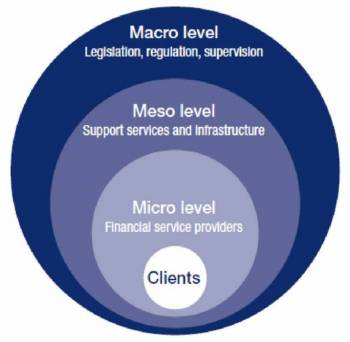
4.2.1 Micro marketing environment analysis
For the analysis of the micro-environment, McKinsey's 7S model is used, consisting of Strategy, Structure, Systems, Management Style, Shared Values, Staff and Skills. McKinsey's 7S model is applied to the FREE Desk product and company in Figure 22.
Strategy – The main strategic objective of our team is to create the project in a limited time: From the 1st of March to the 19th of June with our own resources. These objectives are therefore not long-term. It can be considered a weakness because some parts of the report have not been analyzed as thoroughly as could be. Another objective is to find sponsors for our product. Plus, the team has to find out where there are gaps in the reach of the current market and to make space between well-known established companies.
Structure – The team is organized by assigning tasks according to the capabilities of each team member. We do not have a team leader, so each point is discussed with the team and must be accepted by all members. This structure creates equality between team members. The team is also aware of possible outcomes or misunderstandings.
Systems – In this point we are going to analyze and measure the procedures and processes that the team has to carry out. To discuss the progress done each week, the team has a meeting with the teachers to fix some problems and keep doing the initial Sprint plan. Teacher's feedback helps the team adjust the following tasks to improve the project.
Management Style – We follow the Agile methodology that consists of knowing what each team member is doing during the week and communicating to know how the project is progressing. Decisions are made by all team members in equal circumstances. If some team members have a problem, this will be communicated to the team and it will be possible to help and adjust to any incident.
Skills & Staff – Our team consists of five motivated students. We are all from different study fields and countries. The study fields in our team are: Computer Science, Mechanical Engineering, Industrial Design and Product Development. This means there are a lot of cultural similarities between us, but also some differences. Identifying and organizing work around each team member's specific strengths and skills ensures enhanced team member performance and commitment, as well as increased efficiency, which contributes to a successful project.
Shared Values – In order for the project to succeed, our team has common and important values. The team is motivated and works to preserve ethics. These ethics and values make us stand out and help us make our final decisions.
4.2.2 Meso marketing environment analysis
Meso marketing environment concentrates on the factors that can affect the project inside the company. In Figure 23 those factors are briefly represented.
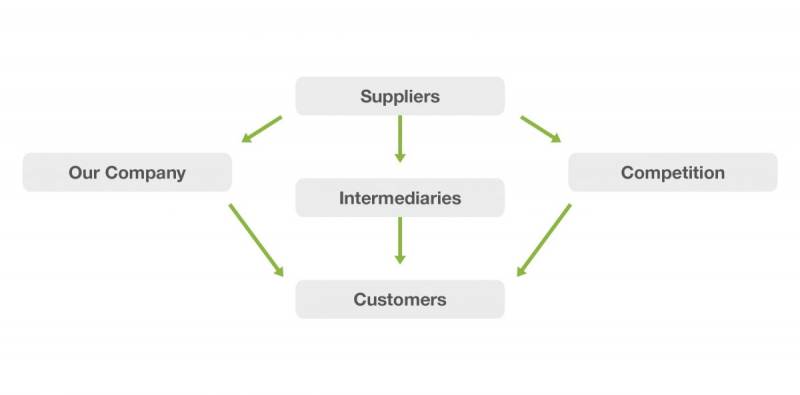
Suppliers – Those from which the team gathers resources needed to produce our desk. A good supplier can be an important part of the business and may contribute to a competitive advantage. Choosing the most appropriate partner and having a strong relationship in the “value-delivery” system marks the key to a good product on the market. The team is mostly focused on finding materials and products from local Portuguese providers that can enable a faster transport. The possible suppliers that suite our needs are listed as follows:
- Wood plates – Vitra [46].
We have chosen these suppliers because they provide quality materials in a short period of time, every one of them having a shop in Porto.
Marketing Intermediaries – The distribution system has a big impact in the selling phase of the product in such a way to be made visible to the public and profitable at the same time. The distributors or retailers provide the invaluable service of getting the product to the customer. This can mark a breaking point in the competition standards as not everyone gets access to the trading market they desire. The team decided to collaborate with local courier services from Portugal that have the necessary experience to deliver everything safely and in time. The primary couriers are Intercourier [52] because it is a service in which we can trust. As another alternative, we have chosen DPD [53] in case the first option is not available or we have complains from the clients.
Potential customer market – Customers are the evidence that the product covers the necessities of masses and demonstrates if the project is valuable or not. In order to compute the best product for the market, the team must locate the customers, analyze their needs and then satisfy them in an efficient and profitable way. Those needs are identified as follows:
- Use space-efficient furniture & save space;
- Save money (investing in one product with multiple usabilities);
- Comfortable working posture;
- More dynamic and efficient working environment;
- An incentive to move and reposition during work;
- Autonomy (integrated battery).
Competitors – Those who target an audience with the same products or services and try to pursue the same sets of customers as ours. The most known desk manufacturers and retailers are mentioned in Table 12, which contains information with all the features of sit-to-stand desks that we consider as our competitors. That enables us to compare features that we will propose, the price, dimensions and functionality in general.
As mentioned before, remote work probably will stay around for some time, so the market is growing. Almost every region in the World have a demand for such solutions. Although this solution may face some challenges like low awareness among people and high cost of replacement, the benefits are appealing. According to Global Standing Desks Market report from 2020 to 2028 there is a rising demand for ergonomic furniture worldwide [54]. With that being said, we will present a competitive matrix to show what other brands offer, with pluses and minuses for each feature. Table 13 will display how our desk looks compared to others.
| VIVO DESK-KIT-1B6B | IKEA RODULF | Allcam Desk | Primecables Sit-Stand desk | FREE desk | |
|---|---|---|---|---|---|
| Target markets | Made for people who works a lot either at home or at office (+) | Made for people who works primarily at home, who like easy solutions minimalistic design (+) | Made for people who works primarily at home, who like easy solutions minimalistic design (+) | Made for needy customers, who work at home or at office, who like advanced solutions (+) | People who work from home, that like minimalistic, functional design (+) |
| Product | - Different color options (+) - Durable for heavy loads (+) - Adjustable width (+) - Can expose you to harmful chemicals (-) - Shipped in two separate boxes, so may not arrive at the same time (-) | - Minimalistic design (+) - Lightest one (+) - No additional features (-) - Not very solid material (-) - One color way (-) | - Minimalistic design (+) - Very light (+) - Different color ways (+) - Solid materials (+) - Smallest strength (-) - Pricy compared to the features (-) | - 3 memory presets (+) - Adjustable width (+) - The greatest height discrepancy (+) - Can carry a huge load (+) - Comes without table top (-) - Heavy system (-) | - Transformable into a bench (+) - Multi-Functional (+) - Charging ports (+) - Lamp (+) - Organizers (+) - Manual lifting system (-) - Boxes take some space (-) |
| Price | Medium retail price (+) | Lowest retail price (+) | Highest retail price (-) | Medium retail price (+) | Medium retail price (+) |
| Place | Only on Amazon (Currently unavailable) (-) | IKEA, online (+) | Allcam website (-) | Primecables (only in US), online (+) | FREE Desk website (+) |
| Potential Competitive barriers | Medium product (-) | Superior product for its price (+); not as functional as others (-) | Inferior product (-); not as functional as others (-) | Superior product (+); very functional (+) | Medium product (-); Has multiple features that stand out against others (+) |
4.2.3 Macro marketing environment analysis
Macro marketing environment shows the external factors which influence the decisions made in a business plan. To have a better interpretation of these analysis, we will be using the PESTLE model, as shown in Figure 24. PESTEL stands for Political, Economical, Social, Technological, Environmental and Legal. This analysis shows the main external factors related to the project and helps the team reduce the risks involved in the development of the product.
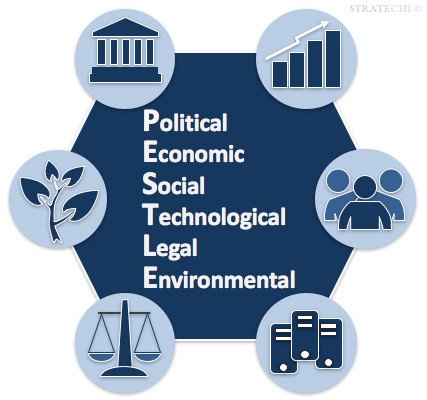
Political
This would include political policy and stability as well as trade, fiscal and taxation policies. Our product does not have a political impact on the society. However, as seen from the pandemic situation, political decisions could have influenced sales of home furniture as many people were forced to work online.
- Opportunities: A crisis similar to the COVID-19 pandemic situation can make the population more interested into home desks.
- Threats: In the same case, similar political decisions can influence the sales negatively.
Economical
These factors impact on the economy and its performance, which in turn directly impacts on the organization and its profitability. These include costs of living, inflation rates, raw material costs and foreign exchange rates.
- Opportunities: Solutions for small costs of living smart.
- Threats: After the pandemic crisis, people would want to settle their costs after months of savings or unemployment.
Social
Social factors include age demographics, ethnicities, and cultural differences. One particularly interesting example is the prominence consumerism in a chosen demographic. This helps a marketer to further understand their customers’ needs and wants.
- Opportunities: In European countries the interest towards materials that do not have such a big impact on the environment is increasing. Also, health issues are considered for a home-office worker.
- Threats: People might prefer automated variants above the manual but cheaper choice.
Technological
Technological factors in our project refer to the development of new technologies and access to established ones, for example the wide utilization of mobile phones and computers/laptops in a working environment, use of the internet on a daily basis.
- Opportunities: Use of the internet to provide advertising and sales. Also utilizing in our product systems that help the user achieve its goals easier (such as charging ports and integrated lamp).
- Threats: New cheaper and more efficient systems can be developed during the creation of the project design.
Legal
Legal factors refer to laws and regulations, such as import and export laws or copyright laws. Political factors do cross over with legal factors; however, the key difference is that political factors are led by government policy, whereas legal factors must be complied with. Regarding legal aspects, our product will follow all of the regulations, not having a particular impact on this area.
- Opportunities: No relevant factors.
- Threats: There are products with similarities on the market already (copyrights).
Environmental
These factors relate to the influence of the environment and the impact of ecological aspects, for example depletion of natural resources, pollution, sustainability, recycling procedures.
- Opportunities: The use of materials from sustainable sources, and where it is not possible, to create the recycling process manageable. Also the population tends to be involved in the environmental problems and choose an eco-friendly solution over others.
- Threats: The use of raw materials also contributes to deforestation and energy consumption.
As a conclusion to these analysis, we can conclude some important points which will help us determine the best solution for further plans regarding marketing. Moving forward, we can develop the SWOT Analysis.
4.3 SWOT Analysis
The primary goal of a SWOT analysis is to help the team identify all the favorable or unfavorable factors regarding the project and evaluate those to make the product better. SWOT stands for Strengths, Weaknesses, Opportunities and Threats. This classification is very useful in the beginning of a project to develop strategic plans that will uncover the possible opportunities and threats as well as pointing out the weaknesses the project has.
Figure 25 represents the Team SWOT analysis and Figure 26 the Product SWOT analysis.
From these SWOT analysis, we can conclude that the current pandemic situation is increasing the customer’s attention into more ergonomic furniture that will help their lifestyle for a long-term period. However, the other competitors on the market have already furnished products with a great visibility to the public and considering that the pandemic is not going to last for a long time, the team needs to find a good strategy that must overlap these threats.
4.4 Strategic Objectives
Strategic Objectives are an important part for organizing the way to create an efficient and productive project. To define clear objectives, we will use the SMART method, because it allows us to manage marketing activities correctly and determine which objective is more important. SMART represents Specific, Measurable, Achievable, Realistic and Time-Bound [56].
Figure 25 shows the SMART objectives in a picture view.
“S” – SPECIFIC: The objectives are clearly defined and every member of the team understands it and why it is important.
“M” – MEASURABLE: The goal needs to be defined with key performance indicators to track the progress and display if everything is on track to achieving these goals.
“A” – ACHIEVABLE: The objectives need to be within the ability of the team, being aware of the existing limitations and resources.
“R” – RELEVANT: Each marketing objective has to contribute to reaching the team’s goals.
“T” – TIME-BOUND: The goals must have a timeline that indicates when it should be done.
General mission and vision strategic objectives:
Economical strategic objectives:
- Develop a business based around adjustable and ergonomic desks which are both profitable and economically sustainable.
- Our goal is to take a spot in the market by creating a reliable solution of products here in Portugal and to contribute to the national economy.
Customer/Learning strategic objectives
- Introduce a sustainable and eco-friendly furniture solution.
- Build relationship with customers (companies) by introducing a high-quality product and service.
Environmental Strategic objectives
- Provide advertising campaign to spread “clean planet/city” awareness. To encourage society to live in a more sustainable way - probably as a long term action.
- To adapt processes to be efficient as possible to reduce carbon footprint.
- To continually adapt to best environmental practices.
Measurable and time-framed objectives in terms of the project:
- Finish selecting the materials and components until May 2021.
- Define the leaflet and redesign the flyer before the 2nd of June 2021.
- Develop an economically sustainable product by using renewable materials.
- Create a website for the product until the 15th of June 2021.
- Build 3D Desk prototype before the 15th of June 2021.
- Finish testing phase before the 15th of June 2021.
- Finish and evaluate the project report before the 20th June of 2021.
- Find sponsors and funding to the business by the end of 2021.
- Popularize and promote FREE Desk by media and online advertising.
- Start selling in European countries at the end of 2022.
4.5 Strategy/Targeting/Positioning/Brand
Strategy/Segmentation
Because strategy has an important role in getting to know the market in which we want to sell the product, we will follow the STP method – Segmentation, Targeting and Positioning as shown in Figure 26.
The first step into the Segmentation part is to configure the elevator pitch which transcribes our orientation towards targeting the current market as displayed below in Figure 29.
On another hand, as our product is designed for a larger audience, we have made a graph to better illustrate the customer’s interests in home desks. This charts (Figure 30 and Figure 31) are part of the demographic segmentation, centered more on the occupation of the customers and the daily usage of a computer at home.
What we can understand from these images is that our market can be segmented for daily users of a computer at home, employees or employers. Which brings us to Targeting.
Targeting
Having configured the segmentation, the team can define the target audience, the customers who can be the most interested in our product. The target market can be seen in Figure 32. We are focusing on the population that work constantly on a computer/laptop, who have to use a desk in order to fulfill their needs in terms of a work environment, male or female, mainly between the ages of 18-45, who desire more comfort, space and ergonomy. This also includes office companies buildings in which our product can help employers create more welcoming conditions for employees.
Positioning
Product’s Positioning is described by the way the product is defined by the consumers on important attributes and thus compared with the competing products. While doing positioning research, we concentrated on competition mapping, which allows us to identify the aforementioned “gap” in the market. Some of the products on display in the state of the art are compared to ours. As seen in Figure 33, the team chose to undertake positional mapping.
The matrix above depicts FREE desk's position in comparison to its competitors. To be the market leader, our product must be the most cost-effective in both production and distribution. It must set itself apart from the competition by innovation, high-quality, and functionality: we aim to provide a high-quality, functional desk to our customers. Our company provides customers with a multifunctional solution that integrates many functions into one furniture made out of sustainable materials and new technologies that distinguishes our desk from other companies.
Brand
According to American Marketing Association (AMA), “a brand is a name, term, design, symbol or any other feature that identifies the seller’s goods as distinct from those of other seller” [57]. We will focus on the Identity of our brand, and that consists of the following:
- Core identity – the brand name – the team has decided to use the brand name FREE, which is an acronym from Furniture, Reconfigurable and Ergonomic. In this way, the brand name refers to the product that we are going to develop.
- Actual identity – the logo. In Figure 34 the brand logo is shown. With this logo we want to strengthen the relationship with the customer and to give him a glimpse about our product.
- Augmented identity – the slogan. We are going to use a simple slogan that it is easy to remember “Make your work space as comfortable as it is functional”.
4.6 Adapted Marketing-Mix
The Marketing Mix or the 4 P’s is a combination of four instruments – Product, Price, Place and Promotion- with which a team can influence a marketing strategy. The Marketing Mix can be used for developing a marketing plan for an existing product or a new product concept. It can be used as a checklist for short-term decision-making and it requires information from previous phases to develop an accurate decision for each point. The Marketing Mix starts with the positioning statement for the new product, including information about the target market and competitive advantage. It is worth noting, however, that the 4P's and concept include marketing instruments from the point of view of the company, not from the client. That is why, in 1990, Robert Lauterborn developed the 4C marketing formula, shown in Figure 34. It covers the same elements as the classic 4P, but seen through the eyes of the consumer.
The FREE Desk Marketing-Mix consists of the following 4 C's which correlate to the 4 P’s:
Customer
The first is the customer. His needs, motivations and goals are in the marketer's focus. His task will therefore be to discover these desires, which implies a much greater emphasis on marketing research. The “product” known from the 4P model is therefore secondary to the prior recognition of the market. It is better to construct a product that will serve your customers after evaluating their behavior.
FREE Desk offers an ergonomic and more sustainable furniture solution for offices that offers more space. The desk also includes all the features that are necessary in the work environment, such as USB port, lamp, drawers and storage space. It is also reconfigurable and can be used as a bench in free time. FREE is designed for a specific target audience, as defined in the previous chapter, and that is people who work from home or office users, who live in a small space and have the desire to save space and be productive.
Cost (Price)
The second C of the model is cost. Therefore, this is the price for the product, but seen from the customer's perspective - as an investment that must be incurred, and not the sum of money that the company will receive in exchange for the purchase. What's more, the term cost includes not only financial issues - it is also the time that the customer has to spend on buying, traveling, ordering goods online or all types of risks associated with the transaction.
Our price should be 2x the price of manufacturing if we want to be able to cover all of our costs, marketing and succeed to grow. At the same time, we should keep the price competitive as our competitors keep the bar as low as possible. Customers are interested in the product, but if the price is out of the perceived utility of the desk, it is not going to be sold. Based on our estimate, the cost of production is 250 € and the price at which it will be sold is 330 €. These costs are just the starting point, as if the demand is bigger, the cost of production will go down as well as the final price of the desks. What seems like an expensive product, it is because of all the functionalities it brings with it.
Convenience (Place)
The third element is convenience. In this case, it is about looking at the aspect of product distribution through the eyes of the customer, focusing primarily on offering him a product or service at the most convenient place and time. It is also all kinds of activities designed to provide him with trouble-free access to product information - a well-functioning website, catalogs and information on social media.
The placement will start here in Portugal as there are local providers and the market here is in need of our product. One of our strategic objectives is to expand our market to other European countries by the end of 2022. As for distribution, it will take around 2 weeks for the product to be manufactured and distributed across the country. The process of placing the order on the internet will take between 10-15 minutes, this depending on how decided the customers are in the process of buying the product, for example comparing it with the competitors.
Communication (Promotion)
The last “C” from the model is communication, equivalent to the classic “promotion”. In 4C Marketing, the brand puts emphasis not so much on informing the client, but on building a deeper relationship with it, thanks to communication activities. This is served by activities in social media, content marketing or all activities that make up customer experience.
This means, having social media accounts, website, phone number, email address and even our first customers. The reason to have a powerful promotion is to make our brand known. FREE Desk will use the website and the free social media, such as LinkedIn, Facebook, Instagram and Twitter, to promote itself. The two main websites that we are going to focus on are Facebook and Instagram. To explain how the product works and what advantages it has, we will create a promotion video and make it available on our website and social media accounts.
To conclude, the 4C concept can be extremely useful. However, the Team should remember that it can be treated as an extension and an alternative approach to marketing instruments. Then any modifications to the product will be derived from research and analysis of consumer needs, and so it will not resemble just to a promotional dialogue, but rather an attempt to build a long-term relationship with the customer.
4.7 Budget
The marketing budget is a pool of funds allocated within the enterprise for the purpose of dynamising the sale of its products on the market. Marketing expenses, like most of the costs, mean some investment, resulting in a certain effect. The main purpose of creating and spending marketing budgets can be:
- increasing brand awareness among consumers and/or business partners;
- increasing the level of purchase of our products, resulting in an increase in the manufacturer's turnover or market share;
- counteracting similar activities of competing companies - protecting their sales or market share.
Marketing is a very important field. Advertisement must be done correctly in order to increase sales of the product and also expand brand name on the market. When it comes to our product, the competition is very strong so we will have to use every tool, for example online advertisement on Facebook and other sites similar to this one, videos and visualizations, posters and leaflets. Our team has decided to create the budget on marketing activities. As is summed up in Table 14, the Team has decided to use most of the money on internet, Instagram and Facebook pages, and also Facebook ads that are seen on both Instagram, Facebook and also LinkedIn. They are paid per a thousand clicks, google ads are also paid per clicks. YouTube will be also a designated place for advertisement in near future. Depending on which advertisement will be most efficient, we will adjust to it and invest more money into those.
| Incomes | Price (€) |
|---|---|
| Budget | 8000 |
| Expenses | Price (€) |
| 700 | |
| 850 | |
| 725 | |
| Google Ads | 900 |
| Leaflets | 400 |
| Official page (website) | 1000 |
| YouTube | 1000 |
| Total | 5575 |
The rest of the incomes will be spent on business trips, like some furniture fairs which would also be very helpful when it comes to advertising the product. We can show all the aspects of our product during those fairs.
If the marketing goes according to the plan, the marketing budget allocated will rise and so our product will be even more visible to the public.
4.8 Strategy Control
When it comes to development process it is very important to follow certain plan. This will help in the efficient development of the company. Deming Cycle or Plan, Do, Check, Act (PDCA) is an iterative, four-stage approach for continually improving processes, products or services, and resolving problems - Figure 36. It also includes always recheck if the actions are beneficial for project success. It is a continuous way to systematically test solutions, assessing results and implementing solutions that are considered good.
These four phases are:
- Plan - it is about assessing current situations, adjusting to trends, predicting some issues and planning things to avoid them in the future. Also it is about establishing some methodology that is going to be followed throughout the whole process.
- Do - this is a phase of executing previously planned actions.
- Check - this phase is about checking if the chosen methodology is correct, whether it needs some corrections or not. This phase is followed until viable results are obtained.
- Act - if the solution was successful them implement it instead adapt it and go through the circuit again.
4.9 Summary
Based on this market analysis, the team decided to create an ergonomic and reconfigurable bench-to-desk intended for home-office users or companies who use offices because there is opportunity for the market here in Portugal. Creating this chapter, the team has defined the main strategic objectives regarding the marketing and analyzed all the factors that can influence the product.
Consequently, the team decided to create a product with adjustable height dimensions using a manual handle which lets the user choose the best position for the use of the desk. It starts from a bench position on which the customer can sit, going up to a standing office position and then to a standing working position, allowing the user to choose freely how he prefers to develop his activity. It also includes all the features needed in this kind of environment, such as a USB port, lamp and storage space with drawers. Our positioning strategy is aimed at obtaining an attractive product that stands out for its low price and efficiency. To promote the product, the branding FREE Desk was chosen and it was decided that the product would be sold on the internet.
In the following chapter, the main characteristics about the sustainability of the product and company will be transcribed.
5. Eco-efficiency Measures for Sustainability
5.1 Introduction
In this chapter, we'll talk about the sustainability of both our product and our company. First, we'll go deeper into de definitions of sustainable development and eco-efficiency. The way we will implement these concepts will be discussed further on, focusing on the three pillars of sustainbility and the Life Cycle Analysis of our desk.
Sustainable development
Our Common Future was published on October 1987 by the United Nations. The report is also known as the Brundtland Report, referring to former Norwegian prime minister Gro Harlem Brundtland. Brundtland was the chair of the World Commission on Environment and Development (WCED). “Our Common Future placed environmental issues firmly on the political agenda; it aimed to discuss the environment and development as one single issue [58].” The report famously defined sustainable development as “Development that meets the needs of the present without compromising the ability of future generations to meet their own needs [59].”
Sustainability is more than just environmentalism; “In addition to natural resources, we also need social and economic resources. Embedded in most definitions of sustainability we also find concerns for social equity and economic development [60].” The concept of sustainability is a holistic approach that covers three pillars; the economic, environmental and social. This approach is shown in Figure 37. The three pillars, sometimes better known as people, planet and people, will each be addressed in this chapter. We don’t want sustainability do be yet another part of the job, it should be a guiding influence for the whole project.
Eco-efficiency
Eco-efficiency is a key concept for companies to reach a more sustainable development, considering not only the added value aspect of its activities but also the environmental impacts [61]. Many companies all over the world have adopted this management philosophy. Eco-efficiency is all about doing more with less. The World Business Council for Sustainable Development (WBCSD) first used the term in 1992 in its publication ‘Changing Course.’ It is based on the concept of creating more goods and services while using fewer resources and creating less waste and pollution [62].
The WBCD outlined the following actions, shown in Figure 38 to implement eco-efficiency.
“Eco-efficient companies use less water, material, and energy while recycling more. Companies that embrace this management philosophy also strive to eliminate hazardous emissions or by-products. They aim to reduce their ecological impact. Eco-efficient companies try to reduce human demands on our ecosystem, i.e., they try to reduce the ecological load [63]”. To say it simply, it means having an effective business while protecting the environment at the same time. We’ll try to apply it to every aspect of business, from producing and purchasing to distribution and marketing.
5.2 Environmental
Regarding the environmental pillar, we’ll be focusing on easy repair, disassembly and recyclability. Eco-friendly furniture should always be easy to disassemble, this way we avoid it ending up in a landfill. It results in easier repairs, which extends the life of the product and also simplifies the recycling for EOL products. Increased recyclability is a very important goal. Furniture accounts for a HUGE (and growing) proportion of landfill waste. The desk should be easy to take apart, sort and recycle at the end of its life.
Our desk will be made out of two materials; solid maple wood and aluminium. We chose solid wood for a number of reasons, one of them being the non-toxicity of the material. We thought about using engineered woods like MDF, plywood or particle board for our desk. “Engineered wood includes a range of derivative wood products which are manufactured by binding or fixing the strands, particles, fibres, or veneers or boards of wood, together with adhesives, or other methods of fixation to form composite material [64].” Manufactured woods are versatile, they lead to a lot of possibilities. They’re also less expensive than solid woods. Materials like plywood or MDF are durable and strong. Plywood, for example, has the best strength to weight ratio. Manufactured woods are often the material of choice when it comes to furniture, but we have some doubts about them. For starters, manufactured wood uses a tremendous amount of energy during the production process. It often contains toxic materials, since formaldehyde often forms part of the glue compounds used during the manufacturing process. Manufactured wood needs to be finished with laminates or veneer, which is also done using glue. Laminates are affordable, incredibly customizable, resistant to scratch and fade and easy to clean. These qualities makes the material a popular choice for desktops but you can’t say that they’re sustainable. Laminates aren’t as strong as solid hardwoods and have a shorter lifespan. The material cannot be refinished (which shortens the lifespan even more) and is also non-recyclable. Bamboo is often promoted as a sustainable material but an immense amounts of energy, water and adhesives are required to re-form bamboo into a wood desktop. On top of that, it’s not recyclable anymore after undergoing that transformation into a desktop. Solid woods are strong and durable and unlike engineered woods, they use very little energy during the production process. No adhesives are needed which makes the material way less toxic than others. It also results in a clean, mono-material that can easily be recycled at the end of its life. The desk made out of solid wood is shown down below, in Figure 39.
For the lifting mechanism, we’ll be using aluminium. The material is supplied by both primary (around 65%) and recycled (around 35%) metal sources. Aluminium can be recycled using only 5% of the original energy input, without any loss of its inherent properties. For our desk, we’ll be purchasing recycled aluminium. “It requires up to 95% less energy to recycle aluminium than to produce primary metal and thereby avoids corresponding emissions, including greenhouse gases [65].” Reducing the amount of VOC’s and keeping our materials clean were the driving factors behind our material choice.
The first feature of eco-efficiency mentioned in the introduction, is reducing the amount of material. We need to find a way to use less material for the desk, while still producing a strong, durable product. Moving very heavy furniture is often more expensive than buying new furniture, especially furniture from fast chains. It’s important to think of ways to keep our furniture more light and flexible, also in terms of transport. Our desk, which is illustrated below in Figure 40, is made out of a table top, two storage boxes and a lifting mechanism. By choosing a solid wood for our desk, our material is quite heavy to start with. By testing our 3D model using simulation software, we can check how thick our material can be too keep it as minimal as possible, while still having a solid and safe construction.
The user will have to assemble the boxes at home. This way the different wooden planks, out of which the storage boxes are made, can be flat-packed. By making the user assembly the desk himself, we also assure that the desk is easy to disassemble. As previously mentioned, this will result in easier repairs and better recyclability. This also makes us more efficient in terms of shipping; if the desk can be partly disassembled and flat-packed, carriers can fill their trucks to capacity and prevent additional delivery trips and fuel stops. This isn’t the only thing we can do to reduce the energy intensity; we should look for more ways to produce our desk more efficiently. We can do this in multiple ways, think about using more energy efficient techniques, recycling wood waste and sawdust, insulation improvement, replacing old machines, … There is a light integrated into the desk, which is a LED light. LED lights are known to be more efficient and last longer, as shown in Figure 41.
As mentioned before, we aim to reduce the dispersion of toxic materials. Solvent-based lacquers contribute to the pollution in your home by emitting volatile organic compounds [66]. Examples of these VOCs off-gassed by furniture are flame retardants and formaldehyde. That’s why we chose solid- over manufactured wood and why we’ll choose to treat our furniture with natural substances. Water-based lacquers are a green alternative to finishing wood furniture [67]. Water-based finishes contain significantly less solvent than conventional solvent-based finishes. This means less solvent that can evaporate into your home environment. This is beneficial for the environment as well as your health. “They are clearer than their solvent-based counterparts and stay that way over time. This makes them ideal finishes for light-coloured woods such as ash, birch, and maple [68].” Water-based finishes don’t require any chemicals when cleaning, just water and soap are sufficient. “In terms of toughness and scratch resistance, water-based finishes score very highly and compare favorably with solvent-based polyurethane [69].”
The use of renewable resources should be maximized. IKEA, for example, has suppliers that turn wood waste from production into a source for renewable energy. On top of being self-sufficient in renewable energy, they’re also able to sell the excess heating [70]. Using recyclable materials like aluminium can help us avoid purchasing additional resources. Greater durability is also something we should achieve. We should step away from the fast furniture model, build things to last and not to throw away. Durable furniture can be passed on if you’re moving or if it isn’t your taste anymore, broken items can’t. Even if its fixable, that will still cost some energy. This brings us too another eco-efficiency measure, namely service intensity. We were thinking about repair points to easily fix up broken components of the desk. Good client service is also of great value. When the user gets left in the dark and doesn’t get proper help, in case of broken or missing items for example, he/she will be more tempted to throw the whole desk away then to try and fix it. Since the desk has to be assembled at home by the user, we’ll have to provide a manual with very clear instructions.
Since we’ll be working with wood, it’s important for us to know the wood is sustainably sourced. Deforestation has a huge environmental impact and we want to avoid that the wood we’ll be using contributes to this problem. We’ll be looking for certified wood to be sure of this. “A product containing certified wood is one where the wood used has been verified as harvested in a sustainable way – including the impact of the harvesting on the surrounding environment in terms of protecting the biodiversity of an area, erosion control and preserving water resources. The certification usually also has some social justice aspects in terms of the way workers in associated forestry operations are treated and the impact on local/indigenous communities [71].” We’ll be looking for wood with a certification from the Forest Stewardship Council (FSC) and/or the Program for the Endorsement of Forest Certification (PEFC), two of the best known certification systems. The FSC describes their certification as being: “..a voluntary, market-based tool that supports responsible forest management worldwide. FSC certified forest products are verified from the forest of origin through the supply chain. The FSC label ensures that the forest products used are from responsibly harvested and verified sources [72].” The Forest Stewardship Council has 10 principles, that are illustrated below in Figure 42. These guiding principles form a basis for all of the FSC standards.
The Program for the Endorsement of Forest Certification (PEFC) is an umbrella organization endorsing 30 national forest certification programs. With the certification of about 800 million acres of land, the Programme for the Endorsement of Forest Certification (PEFC) is the world's largest forest certification system. If a national systems want to be recognized by the PEFC, it must undergo a thorough independent assessment to ensure their compliance with PEFC’s Sustainability Benchmark. The checklist to receive certification from PEFC covers stakeholder involvement, forestry requirements, chain-of-custody requirements, and third-party certification and accreditation requirements [73].
These systems each reportedly have their own set of problems. The most common piece of criticism is that the standards aren’t really applied in practice. We still choose to work with them because there’s not much certainty about whether this is true and the good that’s achieved through these programs still weighs up to the possible downfalls.
5.3 Economical
Nowadays, all big brands make pledges to be more sustainable. This often takes a long time to achieve. “Sustainability encourages businesses to frame decisions in terms of environmental, social, and human impact for the long-term, rather than on short-term gains such as next quarter's earnings report [74]. “It is evident that sustainability embedded in business models and products has the potential to enhance economic growth, return on assets, return on equity, internal rate on return and lead to superior stock market performance [75].” On short term however, companies that commit to the sustainable development of resources may have more modest results in the next term. This makes the whole economical pillar a bit difficult sometimes. It’s of great value to consider sustainability at the beginning of the design phase. This will result in long-term solutions and minimize the need of resources such as material, energy, water, … “If a project is well planned and sustainable criteria are included in its early approach, the possibility to reduce negative impacts is greater and the cost of criteria implementation is greatly reduced [76]”. This is illustrated in Figure 43.
“Instead of trying to “force fit” sustainable principles into an existing and often unreceptive manufacturing system, it may be useful to approach the subject from the opposite direction, and consider how functional objects might be designed and manufactured to be compatible with principles of sustainable development [77]“. We should adopt a different mind-set about costs and focus on increasing the efficiency of the system as a whole. By implementing eco-efficiency measures, we can reduce our ecological impact. Eco-efficiency is all about doing more with less. This translates into an increase in resource productivity, which in turn can create a competitive advantage. Listed down below in table 14 are the seven principles of eco-efficiency outlined by the WBCD, supplemented by our applications of these principles.
| Number | Principle | Application |
|---|---|---|
| 1 | A reduction in the material intensity of goods or services. | - By testing our 3D model using simulation software, we can check how thick our material can be too keep it as minimal as possible, while still having a solid and safe construction. |
| 2 | A reduction in the energy intensity of goods or services. | - Solid woods, unlike engineered woods, use very little energy during the production process. - Because the desk can be partly disassembled and flat-packed, carriers can fill their trucks to capacity and prevent additional delivery trips and fuel stops. - Using LED lights. - Using more energy efficient techniques, recycling wood waste and sawdust, insulation improvement, replacing old machines, … |
| 3 | Reduced dispersion of toxic materials. | - No adhesives are needed when producing the wood which makes the material way less toxic than others. That’s why we chose solid- over manufactured wood and why we’ll choose to treat our furniture with natural substances. Water-based lacquers are a green alternative to finishing wood furniture |
| 4 | Improved recyclability. | - By making the user assembly the desk himself, we also assure that the desk is easy to disassemble. As previously mentioned, this will result in easier repairs and better recyclability. - Our materials are clean, mono-materials that can easily be recycled at the end of their life. |
| 5 | Maximum use of renewable resources. | - We’ll be looking for certified wood to be sure that the maple is sustainably sourced. - The use of renewable resources should be maximized; e.g. turn wood waste from production into a source for renewable energy and sell the excess heating [78]. - Using recyclable materials, can help us avoid purchasing additional resources. |
| 6 | Greater durability of products. | - Using solid materials like hardwood and aluminium, we want to provide a durable product that can last a lifetime. |
| 7 | Increased service intensity of goods and services. | - Repair points to easily fix up broken components of the desk. - Good client service is of great value. - A manual with very clear instructions. |
5.4 Social
“Social sustainability is about identifying and managing business impacts, both positive and negative, on people. The quality of a company’s relationships and engagement with its stakeholders is critical. Directly or indirectly, companies affect what happens to employees, workers in the value chain, customers and local communities, and it is important to manage impacts proactively [79]”. Social sustainability begins with realising that we impact, or can impact, a lot of people. It's important for us to have the support, and approval, of our employees, stakeholders and the community we work in, both locally and globally. We aim to be an inclusive business that strives for equality. On top of that, being socially responsible is profitable in the long-run. It can unlock new markets, be a source for innovation, attract business partners and employees … A lack of social sustainability efforts, on the other hand, can set back business and growth. Think about the Bangladesh factory collapse and its terrible consequences, followed by justified outrage. “While it is the primary duty of governments to protect, respect, fulfil and progressively realize human rights, businesses can, and should, do their part. At a minimum, we expect businesses to undertake due diligence to avoid harming human rights and to address any adverse impacts on human rights that may be related to their activities [80]”.
As a company, we can take social action on the level of our employees and on a more global scale. Concerning employees, it comes down to treating everyone fairly and equally. Good and safe working conditions should always be ensured, just like fair income. Better maternity and paternity benefits, high-quality safety-measures, flexible scheduling, learning opportunities etc. can all help our employees to be more engaged with the company. As well as respecting and applying human rights we want to provide and promote gender equality and workplace diversity. The latter is essential to create a thriving business, especially when it comes to employee engagement. This implies ensuring cultural diversity, gender diversity, religious diversity as well as bringing different education levels and perspectives to the table … Every employee can deliver their own perspective and background which leads to increased creativity and innovation [81]. We should create policies to ensure this diversity system-wide, from recruitment to performance evaluations and promotions. Some of the strategies that can help us with that are already listed above, namely maternity and paternity benefits, high-quality safety-measures, flexible scheduling, allowing employees to take off work for religious holidays that may not be officially observed by the company, … Creating these policies isn’t enough. Clear communication and follow-through is necessary to ensure these policies are effective. Managers should understand the importance of workplace diversity so that employees can feel comfortable coming to them with their concerns regarding their treatment in the company due to their gender, ethnicity, sexuality, age … [82].
On a more global scale, we need to be aware of our entire supply chain and make sure it’s traceable. Is child labour going into our end product? Are all people across our supply chain being paid fairly? On top of that, there are many other ways we can give back to our community. Think about investing in local projects, scholarships, including and supporting marginalised groups, acknowledging and addressing systems of inequality that we work in, women empowerment initiatives …
Using certifications is also important in terms of social sustainability. Certifications like FSC and PEFC, the ones mentioned in the environmental section, contain social justice aspects in terms of the way workers in associated forestry operations are treated and the impact on local/indigenous communities [83]. FSC puts a strong focus on securing workers’ rights. The FSC standards include Core Labour Requirements, which are auditable social compliance requirements. “These requirements include effective abolition of child labour, elimination of all forms of forced or compulsory labour, the elimination of discrimination in respect of employment and occupation, respect of freedom of association and the effective recognition of the right to collective bargaining [84].” The second FSC principle is fully dedicated to protecting workers by specifically upholding their rights and maintaining or enhancing their social and economic welfare.
When talking about deforestation, we should also consider the rights of Indigenous Peoples. Many Indigenous Peoples live and work in forests, or on the surrounding land and are affected by this deforestation. We as a company want to actively support their rights, something we can do by using certified wood. FSC prioritises the right of Indigenous Peoples in Principle 3 of the FSC Principles and Criteria. It requires all FSC-certified forest owners and managers to “identify and uphold Indigenous Peoples’ rights of land ownership, use of land, and access to resources the land may provide [85]”.
5.5 Life Cycle Analysis
“Life cycle analysis (LCA) has been defined by the EPA as a way to 'evaluate the environmental effects associated with any given industrial activity from the initial gathering of raw materials from the earth until the point at which all residuals are returned to the earth' or 'cradle-to-grave' [86].” We can use this tool to quantify and qualify the impact of our desk all across its life cycle. As mentioned before, an LCA begins at the cradle stage with the raw materials. It then goes through all of the manufacturing steps and follows the product during his whole lifetime up untill the grave stage. This can be defined as the moment of disposal and/or recycling.The study applies to the full life cycle of a product and is illustrated in Fig. 44 [87].
In this chapter we’ll try to follow the structure of a real LCA, starting off with our goal definition and scoping.
Goal definition and scoping
We will be designing a flexible home-desk . The desk enables the user to adjust the desk according to their needs. It can be a sitting bench to relax, a normal working desk or a standing desk. This way, the user can decide which position allows him best to focus. We’re focusing on people who live relatively small and who have to turn their home into a working space. In terms of sustainability, we want the desk to be easy to disassemble, repair and recycle. Our focus is also on reducing the amount of VOC’s that can be off-gassed by the furniture. On top of that, we should think of making our product more eco-efficient during its whole lifetime; think about energy-use, transport, …
Inventory analysis and Impact assessment
The use of energy, water, materials and environmental releases (e.g., air emissions, solid waste disposal, waste water discharges) is meant to be identified and quantified in the Inventory analysis. The Impact assessment should contain the estimation of the potential human and ecological effects of everything we identified in the inventory analysis. Given that we don’t have the expertise, time and/or knowledge to calculate this, we’ll instead go through the different steps of developing our desk. The different steps are sourcing, treatment, production, assembly and transport; each one will be discussed in terms of sustainability.
1.Sourcing
We’re using aluminium for the lifting mechanism and solid maple wood for our desk. Aluminium can be recycled using only 5% of the original energy input, without any loss of its inherent properties. By buying recycled aluminium, we benefit present and future generations by conserving energy and other natural resources. Since we’ll be working with wood, it’s important for us to know the wood is sustainably sourced. We want to avoid that the wood we’ll be using contributes to all the problems deforestation brings along. We’ll be looking for a certification from the Forest Stewardship Council (FSC) and/or the Program for the Endorsement of Forest Certification (PEFC), two of the best known certification systems. “A product containing certified wood is one where the wood used has been verified as harvested in a sustainable way – including the impact of the harvesting on the surrounding environment in terms of protecting the biodiversity of an area, erosion control and preserving water resources.
2. Treatment
As mentioned before, we aim to reduce the dispersion of toxic materials. Solvent-based lacquers contribute to the pollution in your home by emitting volatile organic compounds [88]. That’s why we chose solid- over manufactured wood and why we’ll choose to treat our furniture with natural substances. Water-based finishes contain significantly less solvent than conventional solvent-based finishes. They also don’t require any chemicals when cleaning, just water and soap are sufficient.
3.Production
We considered using engineered woods but chose not to because they contain significantly more VOC’s and have a more energy-intensive production process. Solid woods use very little energy during the production process and by using recycled aluminium, we only use 5% of the original energy input.
4. Assembly
The user will have to assemble the boxes at home. This saves space when storing and transporting the desk. By making the user assembly the desk himself, we also assure that the desk is easy to disassemble. As previously mentioned, this will result in easier repairs and better recyclability.
5.Transport
Because the desk is partly DIY, the different wooden planks out of which the storage boxes are made can be flat-packed. This makes us more efficient in terms of shipping; if the desk can be partly disassembled and flat-packed, carriers can fill their trucks to capacity and prevent additional delivery trips and fuel stops.
Interpretation
Normally, the results of the inventory analysis and impact assessment are evaluated here to select the preferred product, components, materials and processes to develop our desk. Because we’re approaching this ‘LCA’ differently, these choices are explained in the previous section. In every step of the development, we’ve tried to minimize our impact on the environment. Easy repair, disassembly and recyclability were central to this process. Besides this, we made sure to avoid VOC’s and be as eco-efficient as possible.
5.6 Summary
Sustainability should be a guiding influence for the whole project. We will develop our desk while always keeping in mind the three pillars of sustainability. Not only will we try minimizing our impact on the environment, we’re also aware of the impact we can have on all of our stakeholders. When it comes to our community, locally and globally, we want to support them and give back, in every way we can. It is important that we have the support of our employees. Economically, we’ll try make efficient choices that will not only benefit the environment, but also our company. Sustainability should be addressed at the beginning of the design stage to reduce negative impacts and the cost of implementation. We aim to design the desk in a way that it is easy to disassemble, repair and recycle. This way, we can prolong the life of our product. By ensuring our desk is robust enough, we avoid it getting thrown away at the end of it’s life.
Next, we'll be taking a closer look at the ethical and deontological concerns related to our product.
6. Ethical and Deontological Concerns
6.1 Introduction
Since ancient times, back when people started to form societies, it became clear, that in order to have a control over people there need to be some rules to be followed. By the trial and error methods, humanity formulated some set of rules regulating our behavior towards each other. If these were neglected, there would be a complete chaos. Those rules have evolved and now are known as unwritten and written code of ethics.
Written code of ethics is giving people a general idea of what types of behavior and decisions are acceptable and encouraged in a society, business company or organization. It is similar to code of conduct, which defines how people should act in certain situation. In most cases those two codes can be combined into one. That give people some rules to follow in order to be ethically correct.
On the other hand we have unwritten code of ethics. The difference is that this code is a unique one, it does depend on the people's point of view, how one's was raised, what values are one's guided by in life. These are also rules that are not written down on paper because they form a part of logical argument implied by tacit assumptions. To see the difference between unwritten and written code of ethics an example will be provided. In sports, where there are two rival clubs, they have an unwritten rule that they don't sign a player from this opposing team.
As we can see ethical code can be very important when it comes to successful managing of an organization or company. Without that there would be a complete chaos. In this chapter, we will present some of the ethical concerns, by analyzing specific fields of ethical and deontological problems such as engineering (6.2), marketing (6.3), environmental (6.4) and legal aspects (6.5). We will also try to compare and fit those rules to our project.
6.2 Engineering Ethics
Engineering is one of the most important and learned profession. Following that statement, engineers are expected to exhibit the highest standards of honesty and integrity. This field of study has a direct and vital impact on the quality of life for all people. Accordingly, the services provided by engineers require honesty, impartiality, fairness, and equity, and must be dedicated to the protection of the public health, safety, and welfare. Engineers must perform under a standard of professional behavior that requires adherence to the highest principles of ethical conduct [89].
The seven canons reflect an attempt to span the potentially infinite range of circumstances in which an engineer's commitment to these fundamental principles may be put to the test. Today these canons read as follows:
1. Engineers are responsible for holding paramount the safety, health, and welfare of the public and shall strive to comply with the principles of sustainable development in the performance of their professional duties.
2. Engineers shall perform services only in areas of their competence.
3. Engineers shall issue public statements only in an objective and truthful manner.
4. Engineers shall act in professional matters for each employer or client as faithful agents or trustees, and shall avoid conflicts of interest.
5. Engineers shall build their professional reputation on the merit of their services and shall not compete unfairly with others.
6. Engineers shall act in such a manner as to uphold and enhance the honor, integrity, and dignity of the engineering profession and shall act with zero tolerance for bribery, fraud, and corruption.
7. Engineers shall continue their professional development throughout their careers, and shall provide opportunities for the professional development of those engineers under their supervision [90].
As a word of introduction to the topic these are just seven fundamental engineering canons. To dig deeper into the topic we will also present rules of practices that engineers needs to follow. If not they are considered to be redundant in the company because of the wasted time and funds. Engineering ethics can be seen as a solution of many ethical difficulties which can come about in the engineering career, but can also become useful for other people who intend to get involved in technical initiatives.
II. Rules of Practice
1. Engineers shall hold paramount the safety, health, and welfare of the public.
- If engineers' judgment is overruled under circumstances that endanger life or property, they shall notify their employer or client and such other authority as may be appropriate.
- Engineers shall approve only those engineering documents that are in conformity with applicable standards.
- Engineers shall not reveal facts, data, or information without the prior consent of the client or employer except as authorized or required by law or this Code.
- Engineers shall not permit the use of their name or associate in business ventures with any person or firm that they believe is engaged in fraudulent or dishonest enterprise.
- Engineers shall not aid or abet the unlawful practice of engineering by a person or firm.
- Engineers having knowledge of any alleged violation of this Code shall report thereon to appropriate professional bodies and, when relevant, also to public authorities, and cooperate with the proper authorities in furnishing such information or assistance as may be required.
2. Engineers shall perform services only in the areas of their competence.
- Engineers shall undertake assignments only when qualified by education or experience in the specific technical fields involved.
- Engineers shall not affix their signatures to any plans or documents dealing with subject matter in which they lack competence, nor to any plan or document not prepared under their direction and control.
- Engineers may accept assignments and assume responsibility for coordination of an entire project and sign and seal the engineering documents for the entire project, provided that each technical segment is signed and sealed only by the qualified engineers who prepared the segment.
3. Engineers shall issue public statements only in an objective and truthful manner.
- Engineers shall be objective and truthful in professional reports, statements, or testimony. They shall include all relevant and pertinent information in such reports, statements, or testimony, which should bear the date indicating when it was current.
- Engineers may express publicly technical opinions that are founded upon knowledge of the facts and competence in the subject matter.
- Engineers shall issue no statements, criticisms, or arguments on technical matters that are inspired or paid for by interested parties, unless they have prefaced their comments by explicitly identifying the interested parties on whose behalf they are speaking, and by revealing the existence of any interest the engineers may have in the matters.
4. Engineers shall act for each employer or client as faithful agents or trustees.
- Engineers shall disclose all known or potential conflicts of interest that could influence or appear to influence their judgment or the quality of their services.
- Engineers shall not accept compensation, financial or otherwise, from more than one party for services on the same project, or for services pertaining to the same project, unless the circumstances are fully disclosed and agreed to by all interested parties.
- Engineers shall not solicit or accept financial or other valuable consideration, directly or indirectly, from outside agents in connection with the work for which they are responsible.
- Engineers in public service as members, advisors, or employees of a governmental or quasi-governmental body or department shall not participate in decisions with respect to services solicited or provided by them or their organizations in private or public engineering practice.
- Engineers shall not solicit or accept a contract from a governmental body on which a principal or officer of their organization serves as a member.
5. Engineers shall avoid deceptive acts.
- Engineers shall not falsify their qualifications or permit misrepresentation of their or their associates' qualifications. They shall not misrepresent or exaggerate their responsibility in or for the subject matter of prior assignments. Brochures or other presentations incident to the solicitation of employment shall not misrepresent pertinent facts concerning employers, employees, associates, joint venturers, or past accomplishments.
- Engineers shall not offer, give, solicit, or receive, either directly or indirectly, any contribution to influence the award of a contract by public authority, or which may be reasonably construed by the public as having the effect or intent of influencing the awarding of a contract. They shall not offer any gift or other valuable consideration in order to secure work. They shall not pay a commission, percentage, or brokerage fee in order to secure work, except to a bona fide employee or bona fide established commercial or marketing agencies retained by them [91].
As can be seen engineering code of ethics is a really wide topic. To conclude this chapter, the goal of an engineer is to get familiar and harness certain knowledge from wide range of fields to create something new, that will lead to improvement of the quality of our life. Some mistakes can lead to a harmful consequences. Every decision needs to be made based on well-established reasoning and knowledge. Therefore, engineering profession involves great responsibility and considers numerous ethical norms. We believe our project must adhere to those guidelines to create a professional and trustworthy brand for our product. In the next chapter we will dig into the marketing and sales code of ethics.
6.3 Sales and Marketing Ethics
When talking about Fair Trade, there are fundamental concepts that organisations and businesses who are claiming to be Fair Trade must adhere to on a day-to-day basis. The World Fair Trade Organisation (WFTO) have come up with the 10 Principles of Fair Trade, as you can see below. WFTO do an amazing job to also ensure these principles are upheld through consistent monitoring.
- OPPORTUNITIES FOR DISADVANTAGED PRODUCERS
Poverty reduction through trade forms a key part of the organisation's aims. It seeks to enable them to move from income insecurity and poverty to economic self-sufficiency and ownership.
- TRANSPARENCY AND ACCOUNTABILITY
The organisation is transparent in its management and commercial relations. It is accountable to all its stakeholders and respects the sensitivity and confidentiality of commercial information supplied.
- FAIR TRADE PRINCIPLES
The organisation trades with concern for the social, economic and environmental well-being of marginalised small producers and does not maximise profit at their expense. Fair Trade buyers, recognising the financial disadvantages faced by Producers and Suppliers of FT products, ensure orders are paid on receipt of documents or as mutually agreed. Where southern Fair Trade suppliers receive a pre-payment from buyers, they ensure that this payment is passed on to the producers or farmers who make or grow their Fair Trade products. Buyers consult with suppliers before cancelling or rejecting orders. Fair Trade recognises, promotes and protects the cultural identity and traditional skills of small producers as reflected in their craft designs, food products and other related services.
- FAIR PAYMENT
A fair payment is one that has been mutually negotiated and agreed by all through on-going dialogue and participation, which provides fair pay to the producers and can also be sustained by the market, taking into account the principle of equal pay for equal work by women and men.
- ENSURING NO CHILD LABOUR AND FORCED LABOUR
The organisation adheres to the UN Convention on the Rights of the Child, and national/local law on the employment of children. The organisation ensures that there is no forced labour in its workforce and/or members or homeworkers.
- COMMITMENT TO NON-DISCRIMINATION, GENDER EQUITY AND WOMEN’S ECONOMIC EMPOWERMENT, AND FREEDOM OF ASSOCIATION
The organisation does not discriminate in hiring, remuneration, access to training, promotion, termination or retirement based on race, caste, national origin, religion, disability, gender, sexual orientation, union membership, political affiliation, HIV/AIDS status or age.
- ENSURING GOOD WORKING CONDITIONS
The organisation provides a safe and healthy working environment for employees and/or members. It complies, at a minimum, with national and local laws and ILO conventions on health and safety.
- PROVIDING CAPACITY BUILDING
The organisation seeks to increase positive developmental impacts for small, marginalised producers through Fair Trade. The organisation develops the skills and capabilities of its own employees or members.
- PROMOTING FAIR TRADE
The organisation raises awareness of the aim of Fair Trade and of the need for greater justice in world trade through Fair Trade.
- RESPECT FOR THE ENVIRONMENT
Organisations which produce Fair Trade products maximise the use of raw materials from sustainably managed sources in their ranges, buying locally when possible. They use production technologies that seek to reduce energy consumption and where possible use renewable energy technologies that minimise greenhouse gas emissions. They seek to minimise the impact of their waste stream on the environment [92].
These were rules concerning ethically correct sales. As a team, we believe that sticking to those rules will help us to establish a good name for our brand on the market. Every single rule will be adapted in further development of our product. Now the marketing aspect will be described in details.
Ethical marketing refers to the process by which companies market their goods and services by focusing not only on how their products benefit customers but also how they benefit socially responsible or environmental causes. It consists of everything from ensuring advertisements are honest in building strong relationships with consumers through a set of shared values. The whole market is associated with constant rat race and if an up and coming company wants to enter the market, it must take into account constant rivalry and competition for the client. In order to attract this customer, companies use all kinds of marketing tactics. Often these tactics can be viewed as „dirty” tricks, unprofessional such as misleading commercials or information that spreads around a product or service. Modern sales management is a complex mix of marketing, people management and negotiation skills and professional selling. On top of that a sales strategy needs to be planned, so good planning skills are also required. As can be seen the whole marketing and sales world is a pretty complex structure and for that to be as fluent as it is there need to be some set of rules. Here are 8 principles of ethical marketing [93]:
- Truth and honesty are appreciated and respected in all types and marketing areas.
- Marketing personnel must follow their personal ethics in their professional activity.
- Advertising for your product should be easily distinguished from news and entertainment.
- The marketing departament should be honest and transparent about who is sponsoring their products.
- Consumers must be treated fairly and respected based on a nature of a consumer and of a product.
- Consumer privacy is appreciated and respected at all times and at all costs.
- Marketing must comply with rules and regulations issued by the government or organisations.
- Ethics should be discussed openly and honestly in all marketing decisions.
When it comes to our marketing, we’ve decided that truth and honesty are the most important factors. We will try not to false advertise and speak openly and transparently about our product. Of course as a team we will also follow our personal code of ethics. Each of us will provide some values to the company. Also we will have to stick to regulations issued by the government. We will also pay attention to the environmental ethics which is next point which we will analyze.
6.4 Environmental Ethics
Environmental ethics is a branch of ethics that studies the relation of human beings and the environment and how ethics play a role in this. Environmental ethics believe that humans are a part of society as well as other living creatures, which includes plants and animals. These items are a very important part of the world and are considered to be a functional part of human life. [94]
Dramatic growth of worlds population led to drastic climate changes. Human acts result in such an environmental pollutions as Industrial and Household Waste, Acid rains, Ozone Layer depletion, Deforestation and Global warming. In order to prevent this fast-spreading danger we need to follow some rules. Of course when it comes to environmental ethic code it is a never ending list. There are three main types of Environmental Ethics [95]:
- Social ecology which is the study of human beings and their relation to their environment.
- Deep ecology promotes that all beings have an intrinsic value.
- Ecofeminism is a branch of feminism that helps us look at earth as a woman so that we can respect it in a better way
Main ethical issue that is heavily related to our project is deforestation. Deforestation is the permanent removal of trees to make room for something besides forest. This can include clearing the land for agriculture or grazing, or using the timber for fuel, construction or manufacturing. Forests can be found from the tropics to high-latitude areas. They are home to 80% of terrestrial biodiversity, containing a wide array of trees, plants, animals and microbes. According to a 2018 FAO report, three-quarters of the Earth’s freshwater comes from forested watersheds, and the loss of trees can affect water quality. Deforestation in tropical regions can also affect the way water vapor is produced over the canopy, which causes reduced rainfall. Trees also absorb carbon dioxide, mitigating greenhouse gas emissions produced by human activity. As climate change continues, trees play an important role in carbon sequestration, or the capture and storage of excess carbon dioxide. Deforestation not only removes vegetation that is important for removing carbon dioxide from the air, but the act of clearing the forests also produces greenhouse gas emissions ([96]. That issue is really serious and we as a team will try not to contribute to that. When it comes ot our wood we will use only certified solid maple wood. Also we will have to find a way of reducing the amount of wood used to desk production in further product development. Our team will also used water-based lacquers, over the solvent-based ones. That will benefit with reducing the VOC's emission.
To conclude this chapter we will try to make our product as sustainable as it can be and of course as least harmful for the environment and that will be done by using eco-friendly materials, like using bubble wrap made of polyethylene which is recyclable over the plastic ones. We will also reduce packaging, reuse some materials and expand the product’s lifespan. After it won’t be useful it will be easy to recycle.
In the next chapter, we will focus on liability ethics.
6.5 Liability
Liability concerns are the legal aspects that are important during designing a product. It aims to make sure that the product follows adequate directives and laws.
For the EPS project, our team must follow these European Union (EU) Directives in order to avoid product liability issues:
1. Machine Directive (2006/42/CE 2006-05-17): concerning machines and deals with such a dangers as explosions, vibrations, radiation, finger joints, dangerous substances in flight, force limits for the operation of machines, minimum safety distance. That directive is not strictly connected with our project [97].
2. Electromagnetic Compatibility (EMC) Directive (2004/108/EC 2004-12-15): intends to regulate side effects between electronic components that are connected/interface together, like electromagnetic radiation, fields in the vicinity of electronic components, etc. On the other hand this directive is more related to our project, as in our case we will have some electronic components [98].
3. Low Voltage Directive (LVD) (2014/35/EU 2016-04-20): deals with safety and health challenges with a use of electrical equipment with defined limits of voltage. This directive is also important for us, as we were thinking about adding a charging port to our desk [99].
4. Radio Equipment Directive (RED) (2014/53/EU 2014-04-16): regulatory framework for placing radio equipment on the market, ensuring no interference and data security regulation in radio communication with other devices. This directive is not strictly connected with our topic [100].
5. Restriction of Hazardous Substances (ROHS) in Electrical and Electronic Equipment Directive (2002/95/EC 2003-01-27): prohibition of the use of certain substances, with the aim to protect the environment and public health. This directive will be our concern as we are aiming to put a battery in our desk [101].
Separate from obeying the directives, another key component is respecting the rights of other brands. By registering a trademark, any company can protect their goods or services. A trademark is a symbol, name, slogan, design, or color that defines and distinguishes a company's brand. It is critical that we consider the trademarks of other existing brands when building our brand, as FREE does not want to infringe on their rights. Intellectual property rights protect trademarks, which is why creating a distinct logo, name, and slogan for the company is critical. Registration gives the right holder legal clarity and improves his or her position, for example in the event of a lawsuit[102].
6.6 Summary
This chapter showed that in order to create, produce and sell a product you need to follow some ethical rules, which helped shaping today’s market. Ethical code need to be respected in order to protect the environment, to create a good reputation and help expand brand’s name in a good fashion and to add some values to the society.
When it comes to our team, we will strive towards an honest and transparent marketing attitude, we will also make sure to follow the standards. On top of that we will try to create as sustainable product as it can be, using eco-friendly materials.
That being said, in the following chapter we will show the actual steps of development of the product.
7. Project Development
7.1 Introduction
In this chapter, the development of our desk will be fully explained. We have divided the chapter in 9 sections, including the summary. In the first section, we will illustrate our solution using sketches, a prototype and a black box. The second section on components will showcase an overview of the materials and components our product is made of, and why we chose those in particular. We'll present our solution using a simulated, as well as a real life, model in the section on functionalities. We've dedicated a section to both the packaging and the transport of our desk. Further, we'll show the results of our tests using simulation software. The website of FREE DESK will be shown in the 8th section, followed by our conclusions on this entire chapter.
7.2 Proposed Solution
In this section, we’ll be showing our process of achieving the final product, which is the FREE DESK. We started out with some initial ideas that we adjusted and improved along the way. A wooden model was made to visualise these ideas. At the end of this chapter a black box diagram is shown, which illustrates how our inputs are converted into our outputs. We'll also elaborate more on our target market.
Illustrated below in table 11 are some sketches. These simple sketches represent our first ideas for an adjustable desk.
After the ideation phase, we started working on the final model. Using wooden plates and sticks, we made a prototype of the desk that shows the three possible levels it can adopt. In table 16 the three posibile positions are illustrated, namely a bench, a sitting desk and a standing desk.
Figure 45 is our proposed solution using a wooden model; a flexible home desk that enables the user to adjust the height. It can be transformed from a bench into a sitting- and standing-desk.
Illustrated in figure 46, is the black box diagram.
Target market
Our target market consists of home-office users who live in rather small spaces. With FREE DESK, we can provide a productive, adjustable and transformable work environment. Our desk has three possible levels, the user can choose which position allows him/her best to focus. Everything that’s on the desk can be stored in the storage boxes; this way the desk can be transformed into a bench and leave no trace. The fact that you can transform your home into an office and the other way around, can be really beneficial for people that live in small spaces. We don’t only focus on the home-office users though, companies can provide their employees more flexibility and autonomy with this desk too.
One of the benefits of the FREE DESK is the possibility to transform it into a bench. You can store everything that was on your desk in one of the two storage boxes and make your desk 'dissapear'. This way, your working- and living-environment can be exactly in the same place. No additional working room is needed, which can be beneficial for those who live in small apartments. Illustrated in Figure 47 you can see the bench configuration.
7.3 Components
This section contains all of the materials and components that will be used in our desk. We will also explain why we chose those in particular, using technological properties and comparisons.
| Nr. Crt. | Item | Part of the FREE Desk | Provider | Dimensions | Quantity | Unit | Unit Price [€] | Total Cost [€] |
|---|---|---|---|---|---|---|---|---|
| 1. | Solid maple wood plate | Table top, Box 1&2 | Vitra | 1 m² (3cm thickness); 3.5 m² (2cm thickness) | 1; 3.5 | m² | to be negotiated based on quantity (€/m²) *approximately 7 €/m² | 31.5 € |
| 2. | Aluminium profiles | Legs, Support for table top, Support for boxes | Aluplasto | 60x2x6.5 mm; 30x2x6.5 mm | 1; 1 | items | 7 €; 5 € | 31 € |
| 3. | V1: Electrical lifting mechanism | Lifting Mechanism | Flexispot | 1125x530x70 | 1 | items | 200 € | 200 € |
| V2: Crank lifting mechanism | Lifting Mechanism | Ketterer | 1125x570x50 | 1 | items | 150 € | 150 € | |
| V3: Sliding Mechanism with Lock Pin | Lifting Mechanism | Amazon | 1125x500x425 | 1 | items | 100 € | 100 € | |
| 4. | Drawer runner | Box | Leroy Merlin | 500×45 mm | 6 (3 pairs) | items | 17.89 € | 107.34 € |
| 5. | Full overlay hinge | Box | Leroy Merlin | 20×60 mm | 2 | items | 1.19 € | 2.38 € |
| 6. | Cabinet drawer push open system | Box | Leroy Merlin | 14x15x114 mm | 1 | items | 7.99 € | 7.99 € |
| 7. | Carbon Steel, Hexagon Threaded Insert Nuts | Box | Fruugo | M6x17 mm | 20 | items | 19.95 € / 20 items | 19.95 € |
| 8. | Screws 7mm | Box | Leroy Merlin | 5×70 mm | 40 | items | 0.10 € | 4 € |
| 9. | Screws 2mm | Box | Leroy Merlin | 5×20 mm | 40 | items | 0.10 € | 4 € |
| 10. | Black Hub 3 Outputs | Tabel top | Aquario | 8x46x28 mm | 1 | items | 8.65 € | 8.65 € |
| 11. | Cable organiser | Box (wire management) | Accezz | 82x20x14 mm | 1 | items | 2.90 € | 2.90 € |
| 12. | Lamp | Table top | Polegada | 200x50x260 | 1 | items | 26.57 € | 26.57 € |
| 13. | Face grain plugs | Boxes (cover screws) | Leroy Merlin | - | 20 | items | 0.75 | 15 € |
| Total cost: | 461.28 € (Electrical lifting mechanism); 411.28 € (Crank lifting mechanism); 361.28 € (Sliding Mechanism with Lock Pin) | |||||||
Materials
We compared different kind of materials for the desk. The frame and the legs of the desk will be made of a metal. For the boxes and the table top, we started looking for a wood material. After a while, we also considered other materials like bamboo, metal, …
There are 3 overarching types of wood available on the furniture market: hardwood, softwood, and engineered wood. “Engineered wood includes a range of derivative wood products which are manufactured by binding or fixing the strands, particles, fibres, or veneers or boards of wood, together with adhesives, or other methods of fixation to form composite material [103].” This engineered (or manufactured) wood includes plywood, MDF, fibreboard, chipboard, etc. and are mostly inexpensive. Often, it is made of wood ‘waste’ like wood chips and sawdust which is a sustainable aspect of the wood but due to the manufacturing process it cannot be recycled. This is why we doubt the sustainability of this materials. Veneer is a thin piece of natural wood that is used a lot in the furniture industry because it creates a natural wood finish. It can be bonded with the manufactured wood that is mentioned above. A veneer surface is resistant to stains and water because it is a natural wood, unlike the layer underneath [104]. The difference between hardwood and softwood is the structure of the wood. Hardwood trees grow slower than softwood producing trees, providing them with a more complex structure. This complex structure creates denser wood fibres, forming a very solid wood. It is also porous, allowing finishes and varnish to settle more deeply in the wood.Hardwood is known to be more durable than softwood, this quality results in the wood being more expensive.
In Table 3 illustrated below, you can see a list of our options for the table top and the boxes with some positive and negative points. We made the comparison more visual by using Figures 20, 7, 37, 38 and 52.
| Material | Explanation | Pros | Cons | |||
| Solid Wood (pine, maple, oak, …) | Solid wood is lumber that has been milled directly from trees. Each type of solid wood has its own characteristics, including its grain pattern, color and texture [105]. | -Strong -Durable -Natural (not synthetic) -Good ability to receive nails and screws -Uses very little energy during the production process -Does not warp as easily as many engineered woods -No fillers or adhesives are used -Easy to repair -Recyclable | -Heavy weight -Expensive -Susceptible to stains |
|||
| Engineered Wood (MDF, plywood, particle board, …) | Manufactured wood is composed of wood fibers that are held together with adhesives. | -Versatile -Durable -Results in smooth surfaces -Flexible -Uses wood waste -Lightweight | -Likely to expand or warp -Has to be finished with laminates or veneer -Uses a tremendous amount of energy as well as potentially toxic materials (since formaldehyde often forms part of the glue compounds used during the manufacturing process) |
|||
| Metal | Metal furniture is a type of furniture that uses metal parts in its construction. There are various types of metal that can be used, such as iron, Carbon steel, aluminium, and stainless steel [106]. | -Durable -Stylish design look -Environmentally friendly (recyclable, doesn't involve cutting of trees or using too many chemicals) -Low maintenance -Affordable | -Can be heavy -Absorbs heat -Poor finishing can result in harm to people/floor/… -Can be considered uninviting |
|||
| Bamboo | A very fast growing grass. The material is strong but flexible, which is a rare combination. | -Strong -Durable \\-More scratch-resistant than most hardwoods -Resistant to swelling and moisture -Some types are antibacterial -Lightweight and easy to move | -Immense amounts of energy, water and adhesives are required to re-form bamboo into a wood desktop -Not recyclable |
|||
| Laminate | Constructed by pressing together layers of heavy-duty paper with a compound known as melamine, which hardens into a resin (creates a solid veneer, which can then be covered in a thin decorative layer) [107]. There's a difference between HPL and LPL: the latter tends to cost less because it is less expensive to manufacture. | -Durable -Affordable -Incredibly customizable -Resistant to scratch and fade -Easy to clean -Flame retardant -Some types have antibacterial properties | -Not as strong as solid hardwoods -Non-recyclable -Shorter lifespan than solid woods -Toxic -Susceptible to water damage -Shows stains and fingerprints -Lack of natural feel -Cannot be refinished |
|||
After comparing these materials, we chose to proceed with a solid hardwood. Besides its beautiful appearance, it is also very strong and durable. As mentioned in the sustainability chapter, we want our desk to be easy to recycle. When using manufactured wood like MDF, this just isn’t possible. Also bamboo, that is often advertised as the sustainable material, is hard to recycle after chemicals have been added. Besides aesthetics and strength, recycliability is one of the main reasons why we chose a solid wood. When just using solid wood for the desk, we keep our materials clean so that our desk can be recycled at the end of its life.
Pressed wood and laminated wood products can result in chemical off-gassing. Volatile organic compounds like formaldehyde can be released this way, something we aim to avoid. “Formaldehyde is used in making resins such as urea-formaldehyde that are used in adhesives for some composite wood products (particle board, fiberboard, and plywood) used to manufacture furniture. Formaldehyde is also found in some paints, lacquers, and coatings used to manufacture wood furniture [108].” This off-gassing can impact the health of employees during the manufacturing process and of consumers by off-gassing in your home environment. We could also consider a metal like steel because of its strength, recyclability and cleanness but we chose wood for a more ‘homy’ feeling of comfort.
We chose solid maple for the desktop and the boxes. We chose this because maple makes for a very good furniture wood. It’s durable, dense, strong and naturally non-toxic. It’s resistant to splitting and moisture and it’s easy to clean. These are all positive points considering that we’re talking about home desks on which, from time to time, the occasional coffee is spilled. Maple is easy to work with and its surface can be polished, stained or painted. It’s a popular choice because it can often be found at attractive prices. The color is light and creamy and the grain patterns is smooth.
To calculate masses and to simulate our tests correctly, we need to use the right properties for our materials. Solidworks has a material library that contains many materials and their properties, like aluminium. The library didn’t contain the right properties for maple wood, so we looked on the internet for those ourselves. Wood is an orthotropic material; its mechanical properties are orientation dependent. In the paper “Characterization of Maple and Ash Material Properties for the Finite Element Modeling of Wood Baseball Bats [109]” we found the right properties for different types of maple wood in the USA. We chose the properties of sugar maple, which is a hardwood maple. Below, in Table 2, you can read the properties we inserted into the solidworks system.
| Property | Value | Unit |
|---|---|---|
| Elastic modulus in X | 12600 | N/mmm² |
| Elastic modulus in Y | 819 | N/mmm² |
| Elastic modulus in Z | 1663.2 | N/mmm² |
| Possion's Ratio in XY | 0,476 | N/A |
| Possion's Ratio in YZ | 0,349 | N/A |
| Possion's Ratio in XZ | 0,424 | N/A |
| Mass density | 500 | Kg/m³ |
| Yield strength | 34.5 | N/mmm² |
Materials
| Material | Explanation | Pros | Cons | |||
| Aluminum | Solid silvery-white metal, 13th element in the periodic table. It is one of the most used material in the engineering because of its properties. | Non-corrosive, Easily machined and cast, light, durable, non-magnetic, recyclable. Cheapest out of all three materials. [110] | Can be easily dented or scratched also compared with steel, so the steel is a little bit stronger material. | |||
| Stainless steel | Iron and chromium alloy. Also wide range of usage in the industry. | High tensile strength, very durable, lasts for a long time, recyclable, resistant for high temperatures, relatively cheap. | Unfortunately it has high maintenance costs, as it has to be painted to be corrosion resistant. Another issue when it comes to stainless steel is buckling, which in our case is important factor. [111] | |||
| Brass | Alloy primarily made of copper and zinc. Known for its bright gold appearance. | Even though brass tarnishes easily, it has high durability. It has anti-bacterial properties. Brass is also easily machined and is corrosion resistant. Has also high tensile strength. Its attractive look can be eye-pleasing. | Can be really heavy. Because of the tarnishes, it quickly gets an old, destroyed look. Can suffer from stress cracking corrosion. It is more expensive than other materials. | |||
When it came to choosing a material from which all the metal parts will be made, we went for aluminum. Firstly we have rejected brass as it has too many major disadvantages. This material is the heaviest out of these three, so that makes our desk harder to lift and also to move around. As mentioned in the table, brass quickly gets tarnished so that will lead to a destroyed look of our desk legs, which will be almost constantly visible. Finally the price of this material is too high. So the decision needed to made between aluminum and stainless steel. Looking at the strength properties, aluminum came out to be a bit better. Actually tensile strength and yield stress are similar in both of these materials. The one factor that decided here was the weight of aluminum, as we won't exert that big of a pressure over the plane of action. Along with being lightweight, it is very strong. Aluminum is also easily recyclable and that factor was really important for us. As mentioned above, we want to have as sustainable product as it can be. Finally, looking from a price point, aluminum is slightly cheaper than steel. So to conclude we have chosen aluminum because it is strong material, despite its lightweight, it also very durable, sustainable and fairly cheap. Illustrated below in Table 4 are the physical and mechanical properties of aluminium.
| Property | Value | Unit |
|---|---|---|
| Density | 2660 | Kg/m³ |
| Elastic modulus | 70300 | MPa |
| Poission's ratio | 0,3 | / |
| Tensile strength | 125 | MPa |
| Ultimate strength | 275 | MPa |
| Maximum allowable stress | 93,75 | MPa |
Materials for building the table
Lifting mechanism
Since we want the desk to be adjustable, we need a fitting mechanism. An adjustable desk has to be adjusted in an ergonomic and efficient way, so that the user feels flexible and comfortable when working from home. Our desk should range between 58 and 115 cm. We’ve come up with these numbers after our state of the art research, in which we compared different sit-to-stand desks. If we can achieve this, we can provide an ergonomic sitting and standing position to all. We would like implement a mechanism that allows the user to stop the mechanism at any level instead of three fixed levels. This way the desk is suited for people who belong to the P5 and P95 segment. Given that the bench is minimally 58 cm and the standing desk is maximum 115 cm, the sitting desk will definitely be suitable for all. By setting the maximum height at 115 cm, the standing position will be long enough for the P95 segment. Table 21 illustrates the comparison between lifting mechanisms used in desks that we found on the market, when doing research for the state of the art chapter.
| Product | Pros and Cons | Price (€) | Picture |
|---|---|---|---|
| Crank mechanism [112] | (+)Durable (+)Wide lifting range (manual or electrical) (+)Comes with a handle/button (-)Expensive (-) Heavy | 83 for manual, 170 for electronic |  |
| Lift-up table mechanism [113] | (+)Quick to lift up (-)Less durable (-)Expensive | 167 |  |
| Automatic Sliding Mechanism [114] | (+)Automated mechanism (+)Can be done handmade (+)Space saving (-)Complex structure (-)Expensive (-)Does not lift heavy weights | Unavailable | 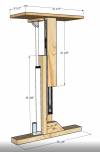 |
| Folding mechanism [115] | (+)Quick (+)Easy to lift (+)Cheap (+)Space saving (-)Lifting range limited (short range) (-)Not durable (-)Small lifting strength | 8 |  |
| Scissor lifting mechanism [116] | (+)Durable (+)Can lift heavy weights (+)Space saving (-)Slow lifting process | Unavailable | 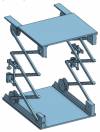 |
When analyzing a lifting mechanism for our desk, the team concentrated on finding the best one that can fit our desk. Our main goal was to find a mechanism that can lift the table top from the bottom position (58 cm high) up to the top position (115 cm high). Another aspect that we were looking at is dynamics and smoothness of the lifting procedure. Last aspect was of course the price. We were looking at the best possible solutions at the possibly lowest price. After analyzing all above mentioned mechanism we came to conclusion that the best one would be electrical mechanism. Ideally it provides us with easy usage and smooth lifting procedure. User doesn’t have to use his/her own strength as the table would raise automatically. That is a plus because sometimes lifting a table back and fourth can be really exhausting. It also has reliable, strong and paradoxically not that complex structure. On the other hand it is pricier than the other mechanisms but the advantages overshadow this one minus. But unfortunately we could find an electrical mechanism that would fit our desk. So by way of elimination we have decided to stick with the crank lifting mechanism and sliding mechanism with lock pins. The first one is a cheaper alternative to electrical system, it also provides us with smooth lifting procedure which is good but on the other hand it has to be adjusted manually. Another problem that we found with this mechanism is its height limitation. The mechanism’s limitations make it hard to adjust the desk at the proper three heights for the three positions, and in this case, for the bench level, the height is 58 cm and for the standing desk, the tabletop can reach a maximum of 110 cm. But after closely analyzing this mechanism the team decides to include this one as our main option. Moving on to the sliding mechanism with lock pins. The mechanism uses spring button clips to adjust height settings. This one has least complicated structure which results in the lowest price out of all solutions. It can also be reconfigured to three different height positions and that is exactly what we are looking for. The one disadvantage that we’ve encountered is an uncomfortable reconfiguration process. But after summing things up we’ve decided to also stick with this one as an alternative crank lifting system. And finally moving on to the last two mechanisms we have rejected. Firstly let’s analyze the pneumatic lifting system. This actually have some advantages like easy and smooth lifting procedure, but besides that we have only encountered minuses. It is quite pricy mechanism and it is not worth the price for what it provides. It also has some height limitations which also affects the rejection of this solution. All in all it can’t provide all the desired features. And lastly the team analyzed the scissor mechanism. It is a cheap and reliable solution which is actually a plus. On the other hand the complexity of this solution overshadows advantages. Not only it is very heavy mechanism and can lift heavy loads but also is has not that eye-pleasing look. Because of that facts it is better to leave this solution in the industrial area where it belongs and not put it in home environment.
We also considered to incline the table top. Table 8 illustrates the comparison between the inclination mechanisms used in desks on the market today. We later decided not too to not overcomplicate the mechanism and minimize the weight and price of our desk. This inclination could be integrated into our desk if we choose to offer different models to the consumer. This way, an inclined table top can be included into a more pricy model.
| Picture | Pros and Cons |
|---|---|
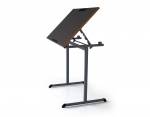 [117] [117] | (+)Space saving (+)Easy to use (-)Fixed values of inclination range (-)Easy to break |
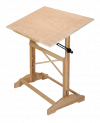 [118] [118] | (+)Space saving (+)Easy structured (+)No fixed values of inclination range (-)Small range of inclination |
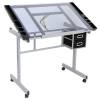 [119] [119] | (+)More stable (+)No fixed values of inclination range (-)Complex structure (-)Easy to break (-)Higher price |
7.4 Autonomous Integrations
Desk Sensor-Lamp
We want to integrate a lamp into the desk that’s automatically switched on when the light intensity in the room is too low. The lamp needs to be foldable so it can be stored into the desk when used as a bench. We found a lamp found on the market that is 180° foldable. The lamp is operated by touch and is rotatable. In this way, the user can choose which parts of the desk are illuminated. The light source is a LED lamp and can be dimmed, according to the mood. The electrical power is 3,2 watts. The lamp works with a battery, namely a Li-ion battery (1200mAh). The battery can be charged at a voltage of 220-240V, ie mains voltage. Because we work with a battery, the user doesn't need to be connected to the main electricity when using the lamp. It just needs charging from time to time, when the user doesn't need the lamp. You can read the charactertics of this lamp below, in Table 18.
| Properties | Value |
|---|---|
| Length (mm) | 200 |
| Width (mm) | 50 |
| Height(mm) | 70 |
| Length foot (mm) | 70 |
| Width foot (mm) | 50 |
| Weight (kg) | 0,44 |
| Battery | Li-Ion (1200 mAh) |
| Lightsource | LED |
| Color temperature (K) | 3000,4000, 5000 |
| Mains voltage | 220-240V, 50/60Hz |
| Switch | Touch driven |
We want to integrate this lamp into our desk; our idea is illustrated down below in Table 7.
The Light-Sensor using Arduino
For the proof-of-concept, we utilized a sensor called LDR (light-dependent resistor) to detect the intensity of light or darkness. When there is a high intensity of light, the LDR permits greater voltages to flow through it (low resistance), and when there is no light, it passes a low voltage (high resistance). The LDR gives out an analog voltage when connected to VCC (5V), which varies in magnitude in direct proportion to the input light intensity on it. Because the LDR produces an analog voltage, it is linked to an Arduino's analog input pin. The Arduino then translates the analog voltage (from 0 to 5V) into a digital value in the range of 0 to 255 using its built-in ADC (analog-to-digital converter) (0-1023). The translated digital values read from the LDR through the Arduino will be in the range of 800-1023, if there is enough light in its surroundings or on its surface. Furthermore, the team programmed the Arduino to activate a relay. It turns on an appliance (light bulb) when the light intensity is low, that is, when the digital values read are greater than normal.
Battery
We researched for batteries available on the market that can provide autonomy of work. This feature is ideal for locations where there are no wall plugs available close by. The integrated battery works as a power tank, providing power for the lamp and also multiple ports for different devices. A battery with a large capacity may provide up to 4 weeks of power on a single charge. Also, the recharging is easy, via a standard USB overnight. As the integrated lamp works with a LED light, it is safe with a 12V supply. A transformer is used, in order to convert voltages from higher to lower values.
Port charger
Employers are more and more embracing the use of cell phones in the modern workspace. Some even try to boost productivity through their employers devices; think of using application like Dropbox to encourage efficiency and work collaboration [120]. Our way of working has become more and more digitalized, especially since the pandemic and our phone has transformed from a distraction to a key element during this transformation. “A surprising study by Frost & Sullivan revealed that use of cell phones adds about an hour of productivity daily. It also states that employees reported an overall increase of 34% in productivity by using their cell phones throughout their workday [121].” None of this would matter if employees couldn’t charge their phone. In the context of home working, it’s very handy for the user to charge his cell phone and other devices close to him. This way, the user can have all that he needs to work within reach and won’t experience any delays by missing a phone call for example.
Total Power Consumption
| Name | Voltage (V) | Current (mA) | Power (W) | Quantity | Price [€] |
|---|---|---|---|---|---|
| 4 port Charger | 100-240 | 6000 | 720 | 1 | 21 |
| Desk lamp | 220-240 | 26 | 3.2 | 1 | 26 |
| LDR | 5 | 0.5 | 0,0025 | 1 | 2 |
| Led light | 3 | 20 | 0,06 | 1 | 0.5 |
7.5 Ergonomics
Ergonomics is one of the mainsprings for this project. Research has linked sitting for long periods with health problems, including obesity and metabolic syndrome — a cluster of conditions that includes increased blood pressure, high blood sugar, excess body fat around the waist and abnormal cholesterol levels [122]. This is why we chose to make an adjustable desk, that allows you to switch from sitting to standing whenever you feel like it.
When it comes to posture, the user should make sure the head, neck, torso and legs stand in line and are vertical. The desk should allow the user to keep his wrists straight and his hands at or slightly below the level of his elbows. The elbow of the user should be close to his body. We advise the user to place the mouse and keyboard at a distance that allows him to do this. If there’s a monitor of a computer on the desk, it should be directly in front of the user, about an arm's length away. The top of the screen should be at or slightly below eye level. By integrating the lamp and the charging ports in the tabletop, key objects such as a telephone can stay close to the users body to prevent excessive stretching. Illustrated in Figure 48 is the ideal posture at both the sitting- and the standing desk. You can see there that the user stands in a straight line with his shoulders relaxed. The elbows are visibly close to the persons body and the wrists are at the level of his elbows.
As seen in the picture, the sitting desk should be somewhere between 25 and 30 inches. This translates to about 64 and 76 cm. The standing desk should be somewhere between 38 and 42 inches, which is about 96 cm and 110 cm. Our measurements should range between 64 and 110 cm, according to these ergonomic measurements. This is the case for each one of our mechanisms. In our desk, the user can adjust the height of the desk themselves (either electrically or manually). This results in an ideal height for everyone who uses our desk. The edges of the tabletop will be slightly rounded to prevent any harm to the user. We informed the user about the ideal ergonomic posture in the manual (ergo_manual.pdf).
7.6 Functionalities
Using our 3D model and a real prototype of the desk, we'll illustrate our design solution. In Figures 54, 49 and 53 you can see the three configurations of the desk.
Table 17 illustrates renders of our 3D model using Solidwords and Fusion.
In Figure 51, you can see the bottom panel of the storage box isn't on the ground. This increase is common in furniture to ensure enough air circulation and avoid damage.
As for the prototype, we have constructed it from an already used adjustable desk, in which we have created the boxes out of PVC boards which were glued together and taped with duct-tape for additional support. As can be seen in Figure 59, the left box has 3 drawers made on the same principle and the right box contains a push-to-open system for the door to be easily opened or closed. Plus, we have put the battery containing the USB ports and the lamp to illustrate all the functionalities our desk provides. Also, in Figure 60 can be seen the desk in the standing position. Although the prototype has a different system to adjust the height, the function is the same and the picture illustrates the position in which someone will work from a standing point.
7.7 Packaging Solution
Nowadays, more and more people tend to care about the sustainability of the products they buy. Companies all over the world are adjusting their current standards to attract the consumers attention. It has become clear that the term ‘eco-friendly packaging’ is more than a buzzword. Implementing eco packaging is no longer an option, it has become a necessity. Using as much eco-friendly materials, whenever possible, is a must. There’s not really something as an ‘eco-friendly’ material, ofcourse some are more friendly to the environment than others but it’s more about how the material is being used and disposed of. Often though, this responsibility falls in the hands of the customer which makes it impossible to know where the packaging ends up. This is why some companies want to take responsibility of their own packaging, and recycle or reuse where they can. This doesn’t only benefit the environment, but can be beneficial for the company as well.
Some companies have already implemented that solution, a great example is Amazon. They provide their customers with the option of sending their boxes back for free. This is limiting the amount of boxes that are thrown away. Besides the fact that it’s beneficial for the environment, it can also attract customers. As mentioned before, more and more people are encouraged by eco-friendly policies.
What criteria must the package meet to be called sustainable? First of all, it needs to be cost effective which means that it benefits and usage are worth at least what is paid for. It also has to be environmentally- and ethically correct. By implementing these kind of policies you can set a good example as a company and take responsibility for your impact on the environment. It’s also beneficial that the packaging can have a wider range of functionality, which we will go deeper into later.
When it comes to furniture packaging in general, there are also some rules that needs to be followed in order to have a sustainable packaging solution. Listed below are the most important ones:
- The size of the package should be adjusted to the size of the product, so there’s a minimum of free space (to limit the size of the packaging and to avoid damaging the product)
- Durability of the of the box should be adjusted to the weight of the product.
- Small elements should be packed in separate bags so they won’t get lost.
- All elements that aren’t packed in separate boxes or bags, should be wrapped in protective foil to avoid any damage.
With this word of introduction we move on to our packaging solution. Our main goal was to minimize our impact on the environment and reuse where we can. Firstly, we decided that we will provide the option of sending the box back to us, as Amazon is doing but with an addition of one feature. The box can be filled with used batteries and packaging from the electrical components that the desk contains. These can be very harmful for the environment, if not disposed of correctly. Collected equipment can later be sorted and transported to appropriate services by our company. If the user chooses not to send the box back, we provide different alternate functions for the packaging which are shown in Table 25. This can be valuable to give the packaging a new life. Now how will we give our packaging a new life? By providing additional, functional, features for on or inside the desk. Think about boxes to store pens in, cardboard drawer organizers, …
Our wooden boxes don’t come with a top layer, partly to limit the weight of our desk. If the user wants to cover the inside of the boxes, he can use a part of the packaging as seen in figure 56.
Our focus was also on limiting plastic and making our materials as recyclable and biodegradable as possible. We have replaced plastic protective foil with a type of bubble wrap made of polyethylene, which is 50% made of recycled material and is fully recyclable. We thought about using either silk or rice paper, but this bubble wrap proves to protect the components better and is as biodegradable as the paper. We’ll also replace the plastic bags that carry our screws with compostable ones; they’re made from a combination of bio-based and synthetic polymer materials. Now moving on to the method of packaging itself. A set of four cardboard boxes is needed to store the wooden panels needed for assembling the desk. As mentioned before, to make our packaging more sustainable we need to manage the space inside in order to have a minimum of free space available. We will flat-pack our furniture so the user can assemble the separate wooden panels at home. This way, we can save a lot of space and we reduce the risk of damaging already assembled drawers or boxes. Each piece of wood will be provided with pre-drilled holes and metal inserts, so the user can simply screw everything together without drilling. All the different wooden panels will be wrapped in the biodegradable bubble wrap. Illustrated in Figure 55, we visualized these boxes filled with the wooden components.
The cardboard will be marked with a dotted line so that the user can easily cut it out to reuse it for the different purposes mentioned above. This is illustrated in figure 57.
Moving on to the metal components; the screws will be packed in compostable string pouch. The lifting mechanism will be partly assembled, with an instruction how to assemble the rest of it. It will also contain pre-drilled holes so it’s ready to be screwed to the wooden boxes. The mechanism will be packed in a separate cardboard box. Lastly, the desk contains some electric components like the lamp and a charging port. Everything will be packed in a separate box, fragile elements will be wrapped in the bubble wrap that was mentioned before.
7.8 Transport
As mentioned in the previous chapter, we’ll be plat packing our furniture. Assembled furniture is expensive to transport and store because you’re actually paying for a lot of air. By flat packing our furniture we can drastically reduce our transportation and warehousing cost. Because we can transport packs of wooden planks in one go, we can reduce our fuel consumption. This results into a reduced carbon footprint and less energy expenditure.
Illustrated in Figure 64, you can see how the boxes can be stacked.
7.9 Tests and Results
Using simulation software, we will assure that our FREE desk is strong enough to withstand the possible loads it will have to endure, both in the bench and desk position. The simulation tests will be performed using Solidworks and the loads will be predetermined by the team. The right properties were found using different sources online [123][124][125].
The lifting mechanisms can carry certain loads. These are tested professionally by the companies who produce them. We did an additional test on the table top to make sure it could withstand the pressure of the user sitting on it. We set the weight of one person at 90 kilograms and used a safety factor of 2, which results in a load of 180 kg (which is approximately 1800N).
By using this safety factor, we can be sure that our desk can withstand this load even if the user is standing on it. We have put the load in the middle of the table, the most vulnerable part. Figure 64 and 62 illustrate how we handled the fixtures to simulate the lifting mechanism and boxes underneath. The left side is prevented from moving in the x-, y- and z-direction. The right side is only prevented from moving vertically.
The results of this simulation is illustrated in Figures 61, 63 and 58. Figure 61 shows us the stress plot, Figure 63 the displacement and Figure 58 the factor of safety.
We can see the maximum displacement, while using double the weight of the user, is 2.3 mm. This is acceptable, given that we’re working with a worst-case scenario. What’s really important is the factor of safety that has been calculated by SolidWorks. . This should minimally be 2, as seen in Figure 70 it’s actually 4. This means our table can withstand this pressure and we can even make our table top lighter. The table top is now 3 mm thick, we’ll change this into 2 mm and run the tests again. By eliminating that extra cm, our desk is now as thick as the boxes. Illustrated in Figures 44, 3 and 42 you can see the results of these tests.
The maximum displacement is now 5 mmm, which is too much. The safety factor is now just a little bit less than 2, namely 1,991. The desk would still be strong enough to carry the weight of one person, given that the safety still has a value of about 2. The displacement is higher than it should be though. We have decided to only eliminate 5 mm of the desktop, resulting in a thickness of 2.5 mm. This results in a factor of safety of 3.5, which is more than enough. The maximum displacement now has a value of 3.4 mm. These final results are illustrated in Figures 74, 46 and 47.
7.10 Summary
In this chapter, we tried to find a solution for the problems stated in the introduction. Since this pandemic, a lot of people are working remotely. We focused on creating a more flexible and autonomous work environment for them. Our target market consists mainly of people who live in small spaces, they struggle even more with this shift to WFH due to lack of space. We started of with some initial ideas that we illustrated with some sketches and later with a wooden model. By making this model and a black box of our product, a clear vision of our product was created. After defining the target market, a comparison of different materials and components followed. We explained our decision to proceed with maple wood and aluminium with technological properties and evaluations between different materials. The strength, durability and easy recyclability of these materials convinced us that they were the best option for our desk. Further, the team looked into different lifting mechanisms and compared their advantages and disadvantages. We chose to offer the user the option to choose out of three mechanisms, according to their budget. The electrical one has the greatest range and is easy to operate, the manual one is a bit more limited in its range and has to be lifted by operating the handle. The last one, the mechanism with the lock pin, is the simplest one to produce and can reach any height but won’t be easy to handle for the user. For the 3D model and the visualisation, we focused on the manual crank lifting mechanism. The range of the crank mechanism is sufficient for our idea and given that it’s manual, we avoid our product being too expensive. Further, we discussed al the features we integrated to make our desk more autonomous. The ideal posture to ensure the desk is ergonomic is explained in chapter 7.5. Afterwards, we visualised our solution using renders. We elaborated on our packaging solution and our choice to flat pack the desk. Simulation tests were performed on the 3D model using simulation software, to ensure the safety of our FREE desk.
The prototype was created using expanded PVC and a reused, transformable desk from our institution. Although the materials limited us in achieving a realistic desk, we tried our best to make it look like our model. We used our research on sustainability and ethics as a guideline for our project. In the following chapter we will conclude our work and discuss some possible future development.
8. Conclusions
8.1 Discussion
The team wanted to create a solution for home office users, following this drastic shift to working from home due to the pandemic. The main objective of this project was to develop an adjustable home desk that enables the user to decide which position allows him/her best to focus. When not in use, the desk should be transformable into a bench so the user can rest or use it for different purposes. After thoroughly looking into different existing desks on the market, papers on ergonomics and the working-from home models, we came up with a list of features that we wanted to integrate into our own design. To achieve a clear view of the project management approach and a structured plan for our project, we applied the Agile Scrum into our work. A marketing plan was created to get to know our target market and to make our product visible to the public, from a business perspective. We also addressed multiple sustainable and ethical issues related to our product. We took these into account from the beginning of the design stage. Initially, the team created a scale model to get a better vision of how the desk would look like. Then, the FREE DESK was developed virtually using 3D software like SolidWorks and Fusion. The functionality was tested using simulations. Following the simulation, some adjustments were made to the model. The thickness of the material was minimalized to a point that the weight and the price of the material could be reduced, without compromising on strength. We also created a physical prototype of the desk, reusing a desk and expanded PVC from the host institution, Instituto Superior de Engenharia do Porto. This simplified version didn’t allow us to simulate any tests. Mainly because both the materials and the lifting mechanism of the prototype are completely different than those of the real desk. The fact that we couldn’t perform physical tests on a model with the right dimensions and materials, limits us in testing the functionality of the desk. Will the user have enough leg space? Will the desk be easy to assemble? Will the push-to-open mechanism work properly? A more realistic prototype will be needed to come up with answers to these questions. Over the course of this project, we have combined our strength to reach our goals. There is still room for improvement, on multiple levels. We’ll dive deeper into this in the future development part.
8.2 Future Development
There is still room for improvement when it comes to the FREE DESK. Due to lack of time as well as experience in this field, we didn’t manage to work out our desk down to the last detail as we planned to. As mentioned before, we’re also limited in testing the functionality of the desk because we don’t have a proper prototype. Listed below are many more possible developments; some need to achieved, others are optional.
- perform additional tests to ensure the health and safety of the user
- further work out the mechanisms
- reduce the weight of the desk
- simplify the assembly
- optimize (reduce) the use of materials
- provide the possibility to customize your desk (besides just the mechanism)
- develop a website and social media platforms to reach our target audience
- improve the design of the desk
- smartify the desk
As mentioned before, we have to perform additional test on a proper prototype, using the intended materials and dimensions. Then, the mechanisms we have integrated up until now can be discussed more thoroughly. Up until now, they are produced by external suppliers. We could think of a way to produce the mechanism our own. Does it have to be electrical? Can we simplify these mechanisms? We will have to work out the different mechanisms we want to provide in a more detailed way and decide if we should outsource the production process. By integrating a simple, manual mechanism like the sliding mechanism with a lock pin for example, we can lower the price and the weight of our desk while also reducing on complexity.
As listed above, the team should also simplify the assembly. We already made it easier by providing threaded inserts, that eliminate the need of a drill. We can still think about minimizing the amount of screws or using a different technique.
In terms of online marketing, we can think of developing a website and social media accounts to promote FREE DESK. For the moment, we offer different models of the mechanism but there’s also the possibility to vary in colour or size and make it more customizable in general.
We could also think of a way to smartify this desk; there are a lot of possibilities in the field. An integrated timer, an app to track your work, … Initially we thought about a several smartifications to make you aware of how distracting your phone is. We stepped away from this idea since our phone is often needed when working and is rather an asset than a distraction, especially since this pandemic.
Bibliography
Will be added automatically by citing, in the body of the report, entries specified in BibTeX format and stored in the http://www.epswiki.dee.isep.ipp.pt/doku.php?id=refnotes:bib file
PS - If you have doubts on how to make citations, create captions, insert formulas, etc. visit this page with examples and select “Show pagesource” to see the source code.
